Sacred Steps to Santiago de Compostela: The Culmination of the Way of St. James
Unveiling the mystique of one of the world's most renowned pilgrimages, join us on a captivating journey, and discover the spiritual quest and cultural wonders of the Camino de Santiago. Step into the footsteps of pilgrims throughout history as we unravel the intriguing tales and profound significance of the Way of St. James. Immerse yourself in the vibrant traditions, awe-inspiring architecture, and soul-stirring landscapes that await pilgrims along this remarkable path.
Uncover the secrets of Santiago de Compostela - the ultimate destination, as we delve into its mystical allure and artistic treasures. Find inspiration and enlightenment as you embark on this transformative pilgrimage, where spirituality and tourism intertwine. Don't miss out on this extraordinary exploration of the Way of St. James. Join us on a journey that will ignite your curiosity, feed your wanderlust, and leave an indelible mark on your soul.
Pilgrimage as Tourism: Embarking on the Way of St. James
Pilgrimage holds a unique allure for travelers seeking a profound connection with history, spirituality, and personal growth. Among the most renowned and revered pilgrimages worldwide, the Way of St. James stands as an emblem of faith, discovery, and adventure. Spanning enchanting landscapes, captivating cultural heritage, and centuries-old traditions, this pilgrimage route offers an extraordinary experience for those who embark upon it.
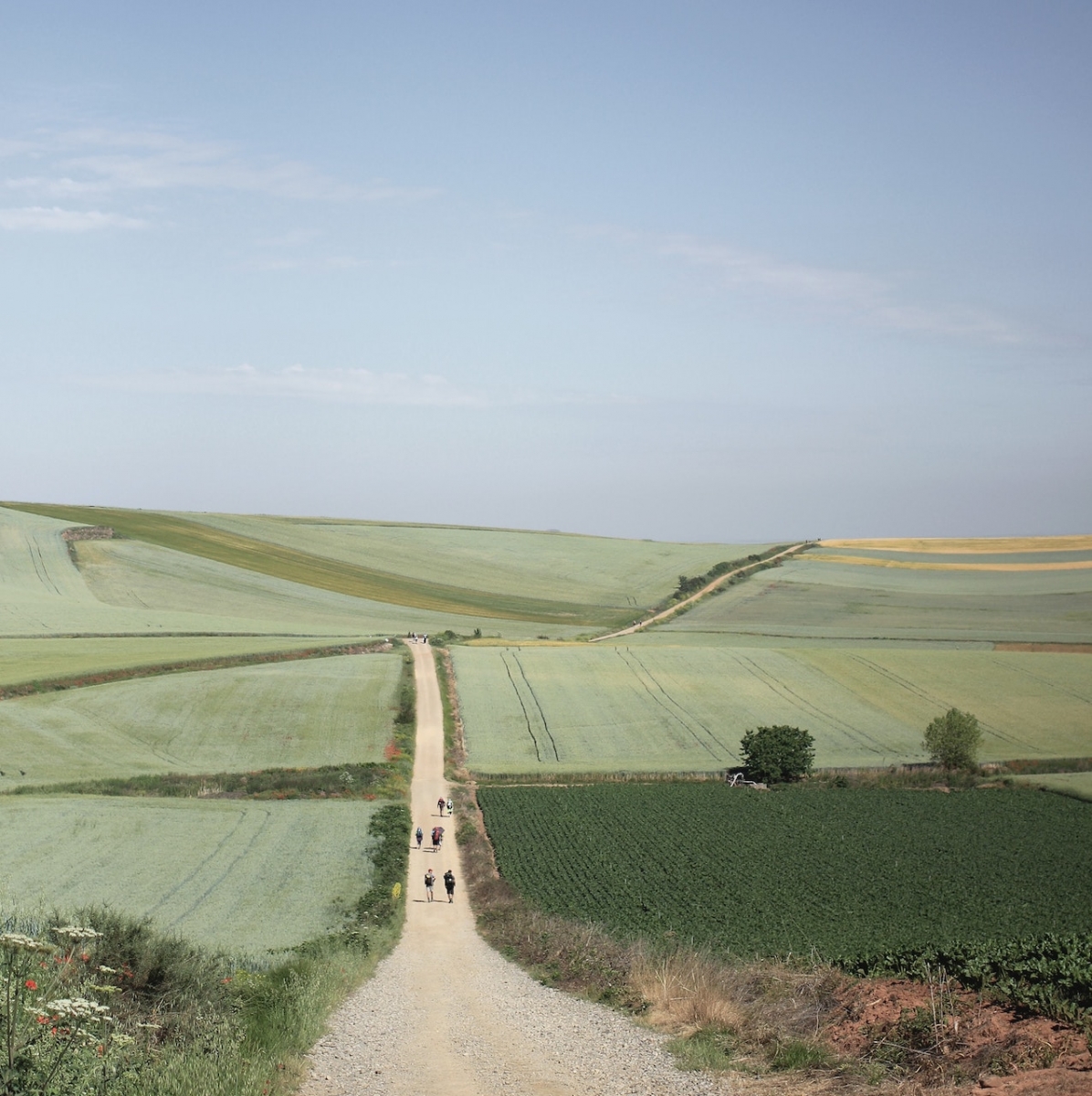
The Historical Significance:
The Way of St. James, also known as Camino de Santiago, traces its origins back to the Middle Ages when it became one of the three major Christian pilgrimages alongside Jerusalem and Rome. The pilgrimage centers around the remains of St. James the Apostle, said to be interred in Santiago de Compostela, Spain. The path itself is an amalgamation of routes, crisscrossing Europe and converging in northwest Spain.
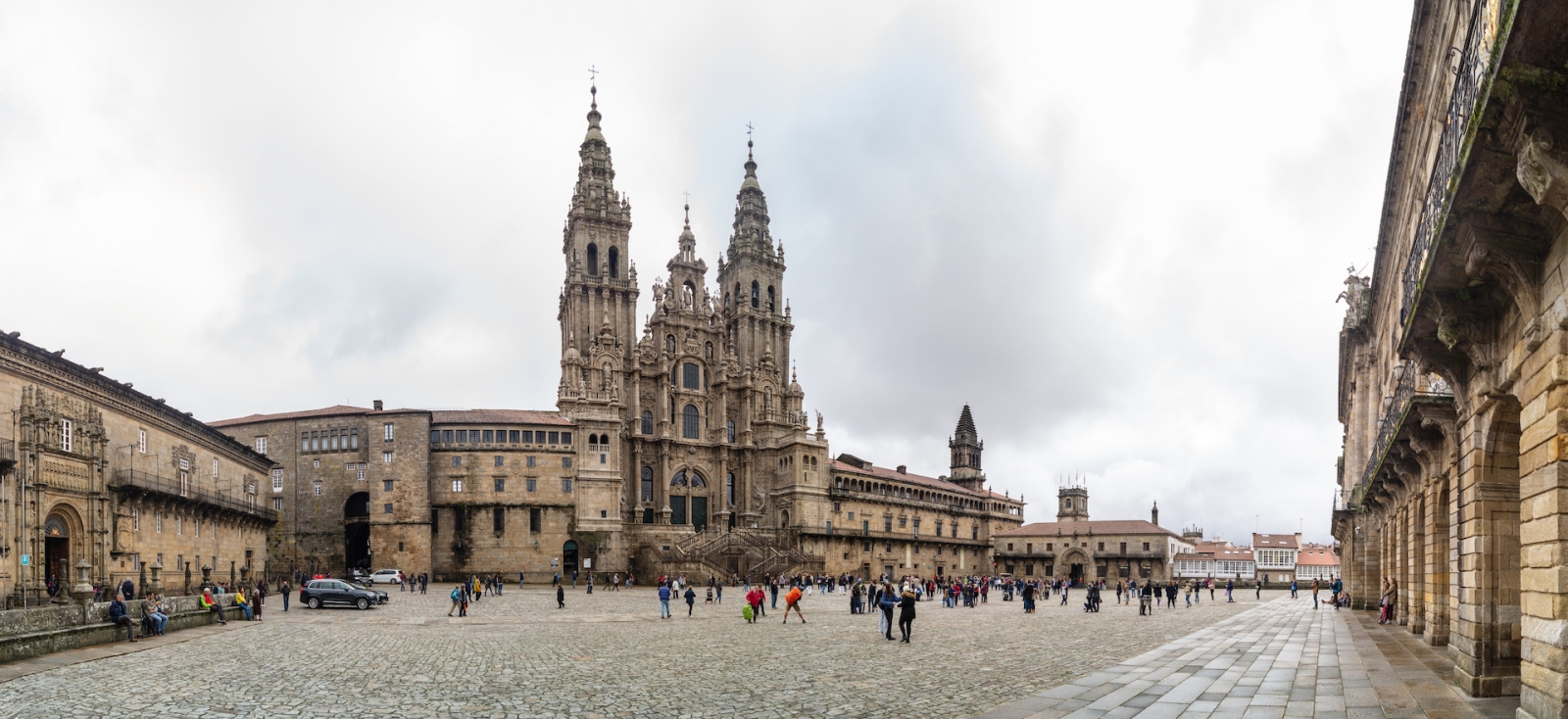
A Journey of Spiritual Awakening:
For many, the Way of St. James transcends a mere travel experience; it is a transformative journey of self-discovery and spiritual enlightenment. Pilgrims from all walks of life, regardless of religious background, undertake this pilgrimage to seek introspection, find solace, and deepen their connection with something greater than themselves.

The Camino Routes:
The Camino de Santiago comprises several routes, each with its own unique character and charm. Some of the notable routes include:
a. Camino Francés: The most popular and well-known route, stretching from St. Jean Pied de Port in France to Santiago de Compostela. It traverses picturesque landscapes, ancient villages, and historic towns, offering a diverse and fulfilling experience.
b. Camino Portugués: Starting from various points in Portugal, this route takes pilgrims through lush countryside, coastal beauty, and vibrant cities before reaching Santiago.
c. Camino del Norte: Following the northern coast of Spain, this route presents breathtaking coastal scenery, rugged landscapes, and encounters with vibrant Basque, Cantabrian, and Asturian cultures.
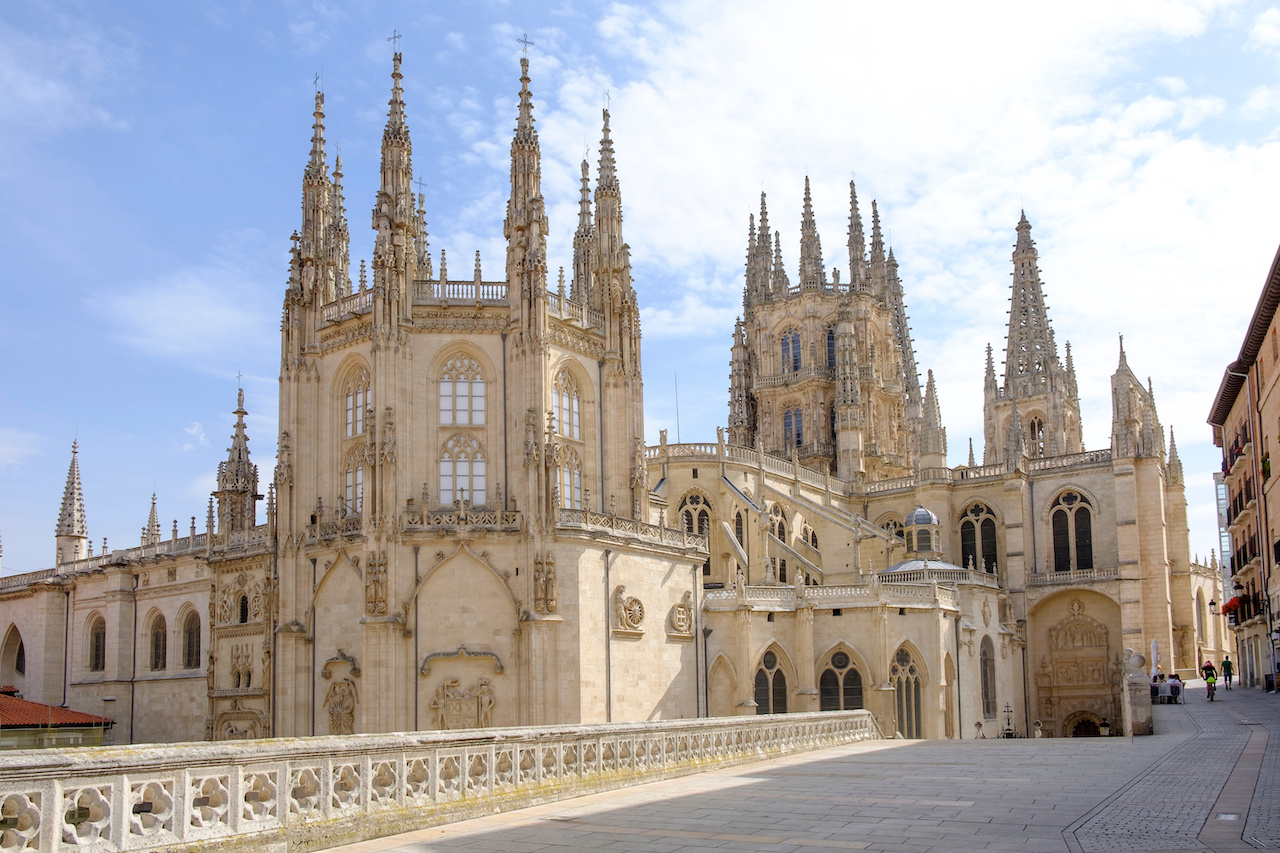
Burgos Cathedral, also known as the Cathedral of Santa María de Burgos, is a magnificent Gothic cathedral located in the city of Burgos, in the region of Castile and León, Spain. It holds great historical, architectural, and cultural significance, and it is considered one of the most outstanding examples of Spanish Gothic architecture. Here is some information about Burgos Cathedral:
History: Construction of Burgos Cathedral began in 1221 and continued for several centuries, with subsequent additions and modifications made over time. It was built on the site of an earlier Romanesque cathedral. The cathedral's construction was closely associated with the aspirations of the Crown of Castile and played a role in the development of the city of Burgos.
Architecture and Design: Burgos Cathedral is renowned for its stunning Gothic architecture. The cathedral features elaborate stone carvings, pointed arches, ribbed vaults, and towering spires. Its intricate façade showcases a harmonious blend of decorative elements, including statues, reliefs, and intricate tracery. The interior is equally impressive, with a spacious nave, beautiful stained glass windows, and ornate chapels.
UNESCO World Heritage: In 1984, Burgos Cathedral was designated as a UNESCO World Heritage Site. It was recognized for its architectural excellence, artistic significance, and its representation of the Burgos school of Gothic architecture. The cathedral stands as a testament to the rich cultural and historical heritage of the region.
Tombs and Artistic Treasures: Burgos Cathedral houses numerous tombs and artistic treasures. One of the most notable features is the Chapel of the Constable, which contains the tomb of Don Álvaro de Luna and his wife, considered a masterpiece of the Spanish Renaissance. The cathedral also houses impressive altarpieces, sculptures, and religious artworks from various periods.
Pilgrimage Connection: Burgos is an important stop on the Camino de Santiago, specifically on the Camino Francés. Many pilgrims visiting Santiago de Compostela pass through Burgos and take the opportunity to visit the cathedral. The Pilgrim's Mass, held daily, is a significant event for pilgrims, creating a spiritual connection between the pilgrimage tradition and the cathedral.
Cultural and Tourist Hub: Burgos Cathedral is not only a religious and architectural marvel but also a cultural and tourist hub. It attracts visitors from around the world who come to admire its grandeur, explore its artistic treasures, and experience its profound spiritual ambiance. The cathedral is also the venue for various cultural events, including concerts, exhibitions, and religious ceremonies.
A visit to Burgos Cathedral offers a captivating journey through the ages, immersing visitors in the splendor of Gothic art and architecture. It stands as a testament to the skill and dedication of the craftsmen who contributed to its creation and serves as a symbol of the rich cultural heritage of the city of Burgos and the wider region of Castile and León.
Cultural Heritage and Architectural Splendors:
Along the Way of St. James, pilgrims are immersed in a tapestry of architectural marvels and cultural heritage. The path leads through medieval towns, Romanesque churches, Gothic cathedrals, and enchanting monasteries. Noteworthy landmarks include the magnificent Burgos Cathedral, the Roman bridge of Puente la Reina, and the grand Cathedral of Santiago de Compostela.
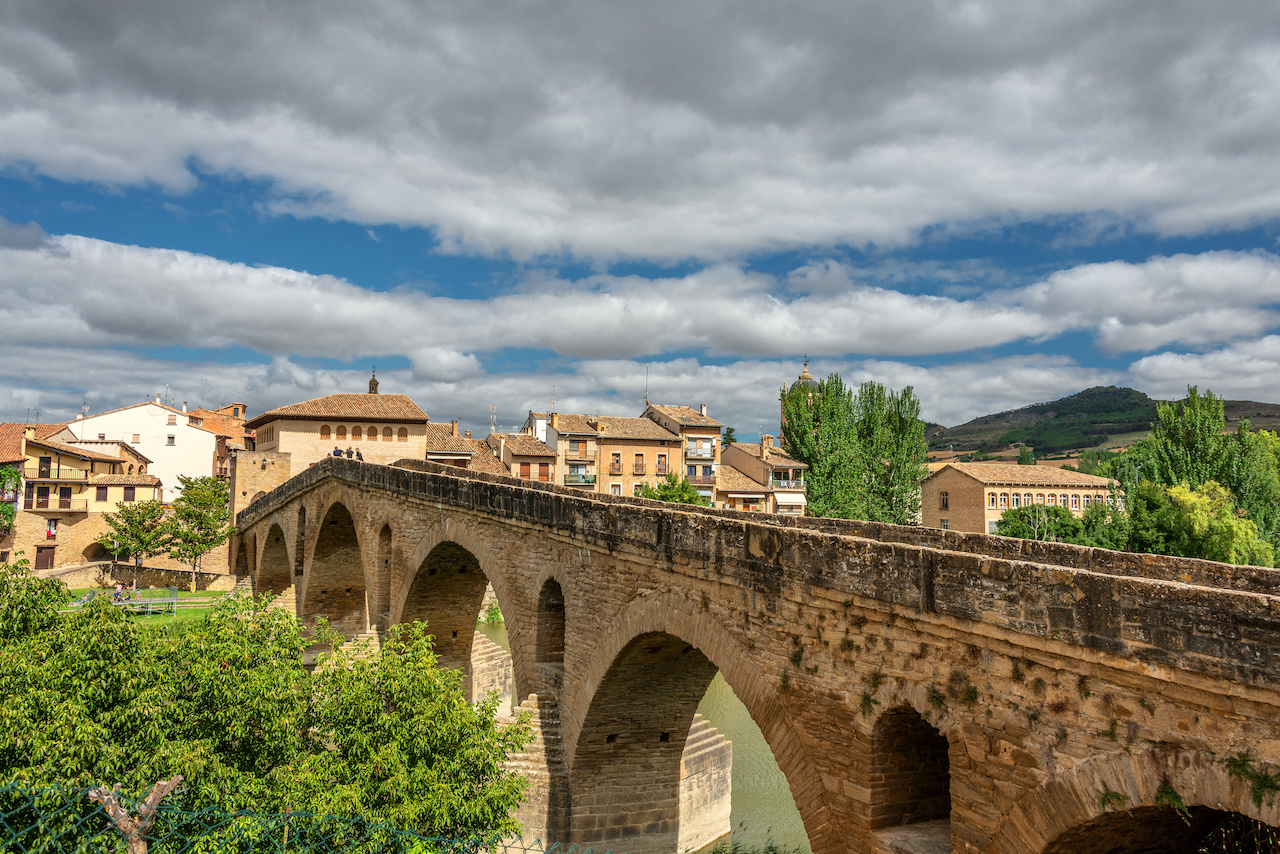
The Roman bridge of Puente la Reina, also known as Puente Románico, is a historic bridge located in the town of Puente la Reina in the region of Navarre, Spain. It is an iconic landmark along the Camino de Santiago, specifically the Camino Francés, which is one of the major routes of the Way of St. James.
Here are some key details about the Roman bridge of Puente la Reina:
History: The bridge dates back to the 11th century and is believed to have been constructed on the foundations of an ancient Roman bridge, hence its name. It was built during the reign of Queen Doña Mayor, who gave the town its name, which translates to "the queen's bridge."
Architecture and Design: The bridge is a magnificent example of medieval architecture. It spans the Arga River and consists of six pointed arches, each supported by robust piers. The stonework displays the characteristic Romanesque style of the period, with its solid and sturdy construction.
Pilgrim Route: The Roman bridge of Puente la Reina holds immense significance for pilgrims on the Camino de Santiago. It serves as a crossing point for pilgrims heading towards Santiago de Compostela. The bridge marks a juncture where two major routes, the Aragonese Way and the French Way, converge.
Strategic Location: Puente la Reina, the town where the bridge is located, holds historical importance as a key point along the Camino de Santiago. It was strategically established to facilitate the pilgrimage journey, providing essential services, accommodations, and places of worship for pilgrims.
UNESCO World Heritage: The Roman bridge of Puente la Reina is part of the larger Camino de Santiago pilgrimage route, which has been designated as a UNESCO World Heritage Site. This recognition highlights the historical and cultural significance of the bridge and its role in the pilgrimage tradition.
Architectural Conservation: The bridge has undergone restoration and conservation efforts over the years to ensure its preservation. These efforts aim to maintain the structural integrity of the bridge while safeguarding its historical and cultural value for future generations of pilgrims and visitors.
Visiting the Roman bridge of Puente la Reina offers a unique opportunity to witness a remarkable medieval structure and experience the historical spirit of the Camino de Santiago. It serves as a tangible connection to the pilgrimage tradition and stands as a testament to the enduring legacy of the Way of St. James.
The Pilgrim's Rituals and Traditions:
Pilgrims engage in age-old rituals and traditions that enrich their experience and foster a sense of camaraderie. The most symbolic act is the presentation of the "credencial" or pilgrim's passport, which grants access to albergues (pilgrim hostels) and serves as a record of the journey. The pilgrim's meal, known as the "pilgrim's menu," offers a chance to savor local cuisine and share stories with fellow travelers.
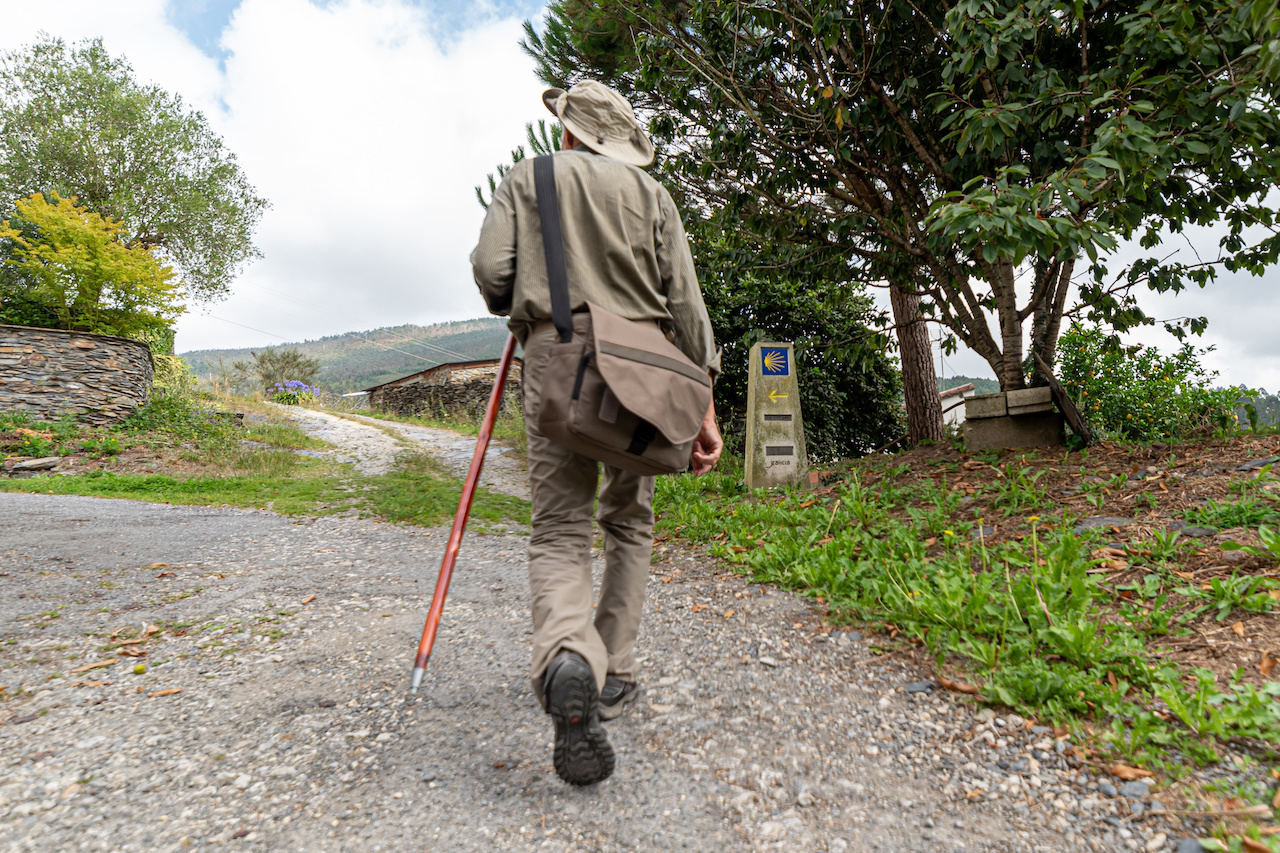
Embarking on the Way of St. James is a captivating fusion of spiritual devotion, physical challenge, and cultural immersion. Whether one seeks introspection, adventure, or a deeper connection with history and heritage, this pilgrimage as tourism offers an unforgettable odyssey. As pilgrims traverse the ancient trails, they become part of a timeless tradition, walking in the footsteps of countless seekers who have found solace, inspiration, and renewal on this sacred path.
Other notable pilgrimage routes in both Christian and Muslim religions
In addition to the Way of St. James, there are several other notable pilgrimage routes in both Christian and Muslim religions. Here are some examples:
Christian Pilgrimage Routes:
Via Dolorosa (Way of the Cross), Jerusalem, Israel:
This pilgrimage route traces the path believed to have been taken by Jesus during his crucifixion. It encompasses 14 stations, beginning at the Antonia Fortress and ending at the Church of the Holy Sepulchre.
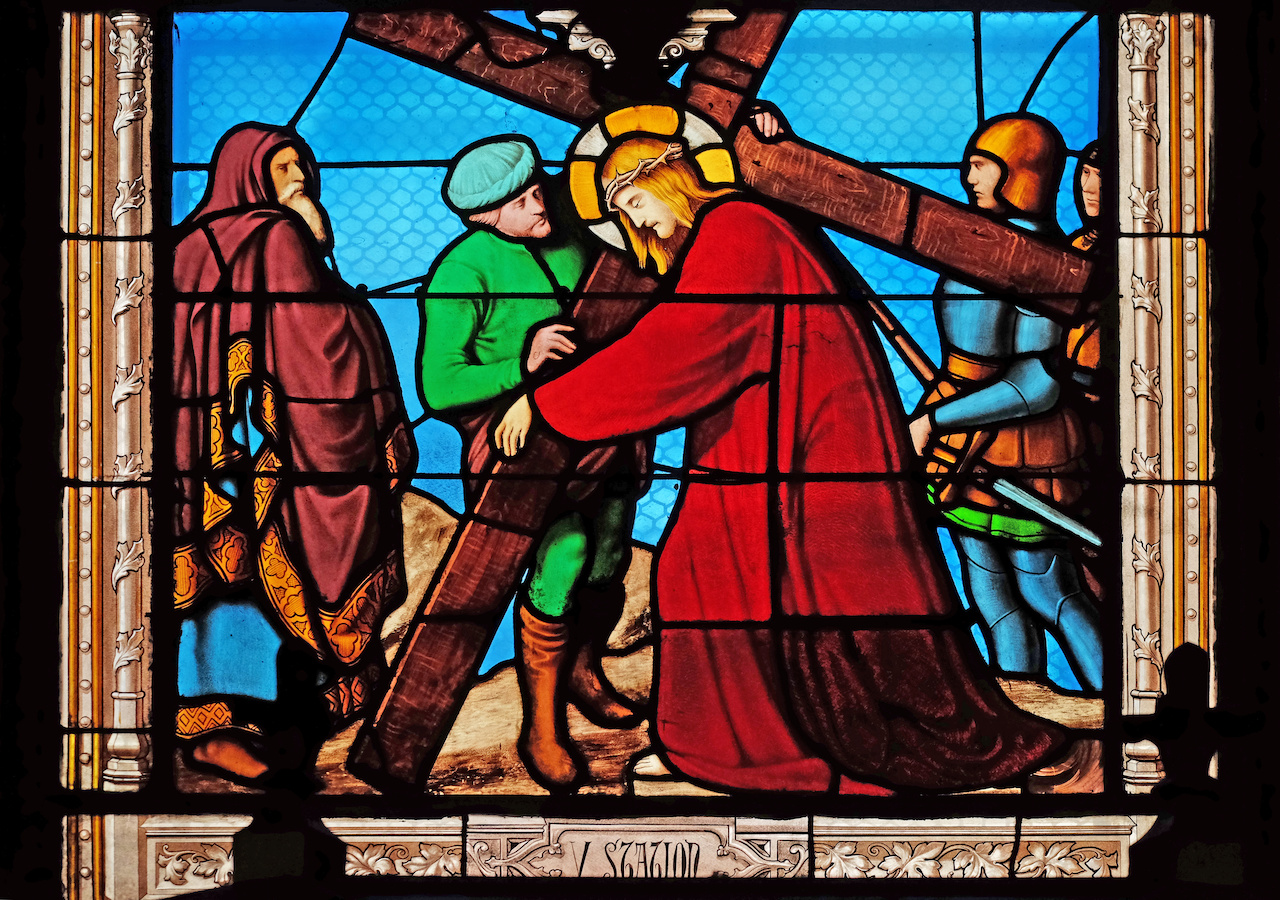
The Holy Land Pilgrimage, Israel and Palestine:
The Holy Land is significant to Christians as the birthplace of Jesus and the setting for many biblical events. Pilgrims visit sites such as Bethlehem, Nazareth, the Sea of Galilee, and Mount Sinai, following the footsteps of Jesus.
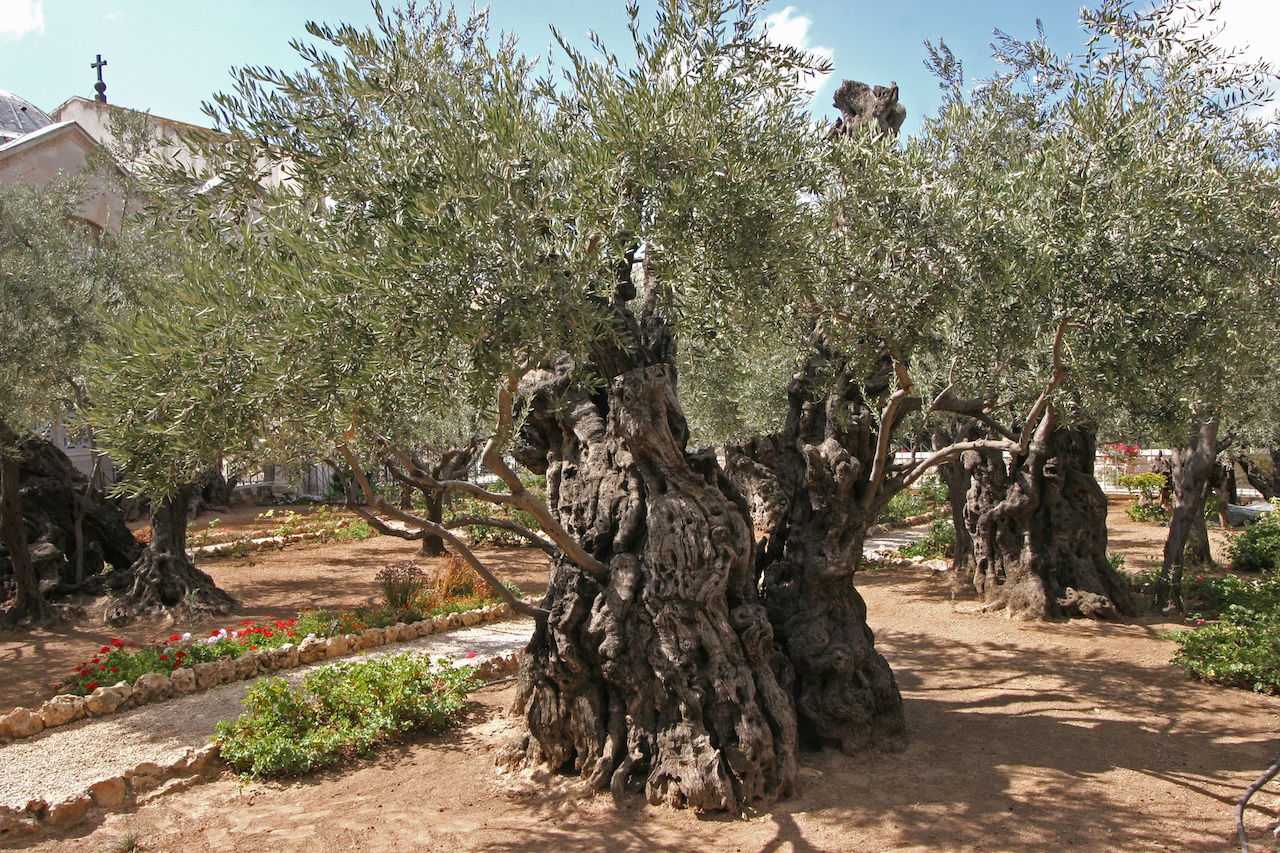
Camino de Guadalupe, Mexico:
This pilgrimage route in Mexico honors the Virgin of Guadalupe, the patroness of the Americas. Pilgrims journey to the Basilica of Our Lady of Guadalupe in Mexico City, where the image of the Virgin is housed.

Muslim Pilgrimage Routes:
Hajj, Mecca, Saudi Arabia:
Hajj is the annual Islamic pilgrimage to the holy city of Mecca. It is one of the Five Pillars of Islam and a mandatory religious duty for Muslims who are physically and financially capable. The pilgrimage includes rituals at the Kaaba, circumambulation of the Kaaba, and other significant sites.
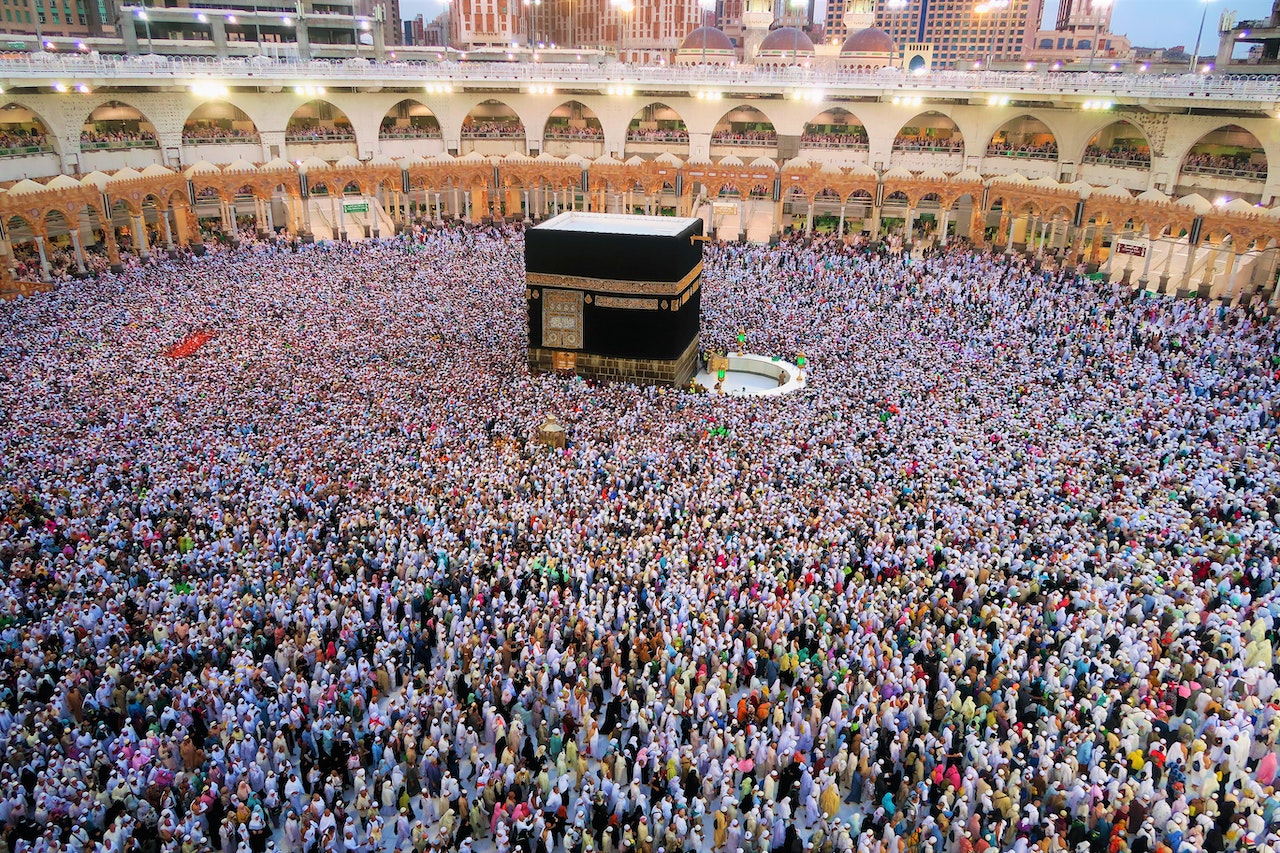 Umrah, Mecca, Saudi Arabia:
Umrah, Mecca, Saudi Arabia:
Umrah is a non-mandatory pilgrimage that Muslims can undertake at any time of the year. It involves a series of rituals similar to Hajj but with fewer obligations. Many Muslims combine Umrah with their Hajj journey.
Ziyarat, Various Locations:
Ziyarat refers to a pilgrimage to significant Islamic sites associated with prophets, imams, and holy figures. Some prominent destinations include the Prophet's Mosque in Medina, the Shrine of Imam Hussein in Karbala, Iraq, and the Al-Aqsa Mosque in Jerusalem.
These are just a few examples of the pilgrimage routes in Christian and Muslim religions. Each route holds its own historical and religious significance, attracting countless pilgrims seeking spiritual fulfillment, cultural immersion, and a deeper connection with their faith.

Scallop symbol of the Way of St James
The scallop shell holds deep symbolism in relation to the Way of St. James pilgrimage and has become an iconic emblem associated with the journey. Here's an explanation of why the scallop shell is significant and how it is used on the pilgrimage and in religious contexts in general:
Legend of St. James and the Scallop Shell:
According to Christian tradition, after the death of St. James the Apostle, his body was transported by boat from Jerusalem to Galicia, Spain. Upon arrival, the boat was covered in scallop shells. This led to the belief that the scallop shell became a symbol of St. James and his connection to the sea.

Wayfinding Symbol:
The scallop shell serves as a wayfinding symbol along the Way of St. James. Pilgrims affix the shell to their backpacks, hats, or clothing as a recognizable marker. The shells are often displayed on signposts, walls, and pavements to guide pilgrims along the route. They indicate the correct path to follow, ensuring that pilgrims stay on course.
Pilgrim's Credential:
The scallop shell is an integral part of the pilgrim's credential, also known as the pilgrim's passport. Pilgrims carry this document and collect stamps along the route to prove their progress. The shell symbol is prominently displayed on the credential, indicating the pilgrim's journey on the Way of St. James.
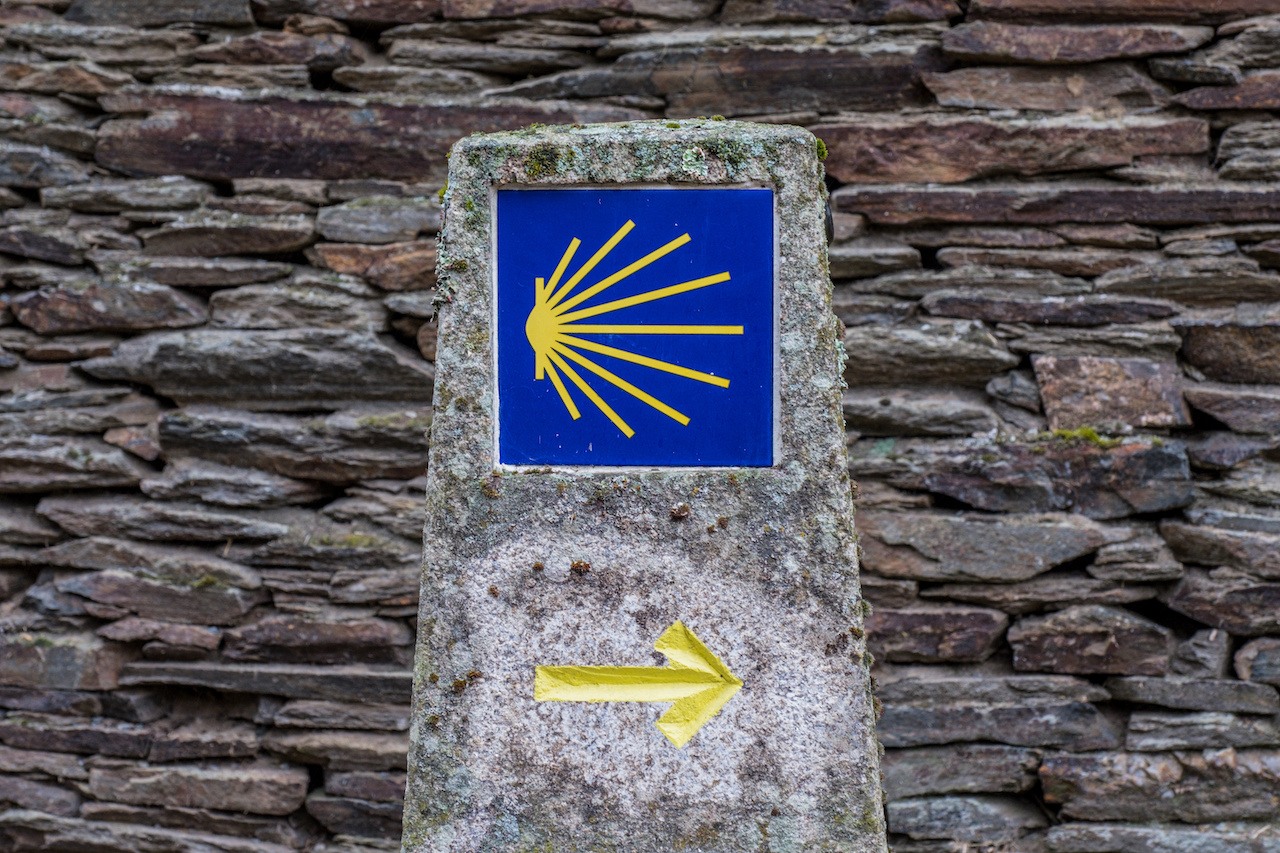
Symbol of Pilgrim Identity:
Wearing the scallop shell has become a way for pilgrims to identify themselves and connect with fellow travelers on the pilgrimage. It fosters a sense of camaraderie and community among pilgrims, regardless of nationality, language, or background.
The Symbolism of the Scallop Shell:
The scallop shell carries various symbolic interpretations. One interpretation suggests that the lines on the shell represent the different routes leading to Santiago de Compostela, converging at a single point, much like the pilgrims themselves. The shell's ridges are also seen as symbolic of the spiritual journey, with each ridge representing a stage of personal growth and transformation.

Religious Symbolism:
Beyond the Way of St. James, the scallop shell holds broader religious symbolism. In Christianity, it is associated with baptism and pilgrimage in general, representing rebirth, purification, and the spiritual journey toward salvation. The shell's curved shape has also been likened to a pilgrim's head bowed in prayer or a vessel receiving divine grace.
The scallop shell's use on the Way of St. James and in religious contexts encapsulates its multifaceted significance as a navigational aid, a symbol of identity and community, and a representation of spiritual pilgrimage and rebirth. Its enduring presence on the pilgrimage route adds to the rich tapestry of traditions and symbols that make the Way of St. James a unique and meaningful experience for pilgrims from around the world.
The History of the Way of St. James
The history of the Way of St. James, also known as the Camino de Santiago, dates back over a thousand years. Here is an overview of its origin and development.
The origin of the Way of St. James is rooted in legend and religious tradition. According to Christian tradition, the apostle St. James (Santiago in Spanish) preached the gospel in the Iberian Peninsula before returning to Jerusalem, where he was martyred. After his death, his disciples are said to have brought his body back to Galicia, Spain. Legend has it that his remains were buried in what is now the city of Santiago de Compostela.
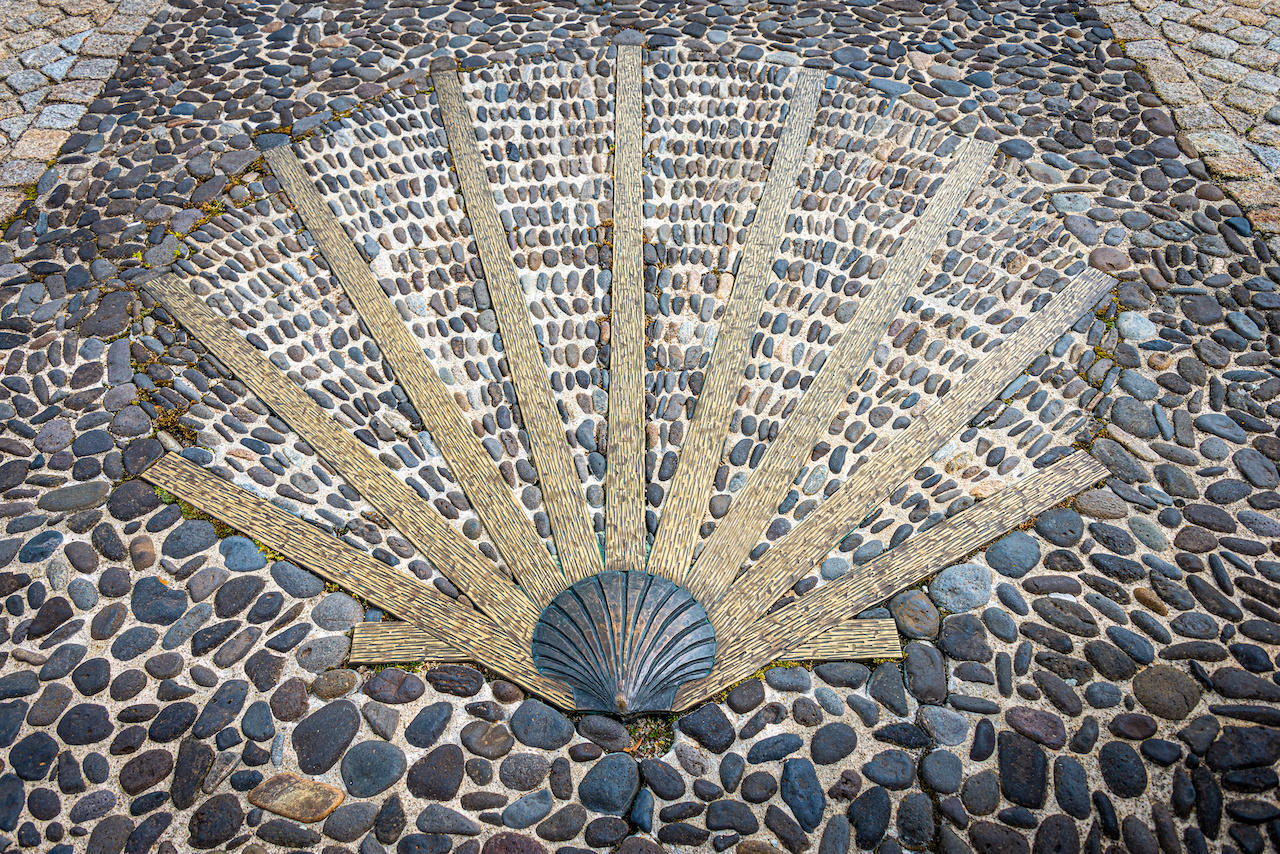
In the 9th century, a hermit named Pelayo is said to have been guided by celestial signs to the tomb of St. James. This discovery led to the recognition of Santiago de Compostela as a significant Christian pilgrimage site. As news spread, pilgrims from various parts of Europe began making the journey to pay homage to the apostle and seek spiritual blessings. The pilgrimage gained popularity throughout the Middle Ages, becoming one of the three major Christian pilgrimages alongside Jerusalem and Rome.
As the pilgrimage grew, multiple routes, collectively known as the Camino de Santiago, emerged. These routes branched out from different parts of Europe and converged in northwest Spain. The most prominent and widely traveled route is the Camino Francés, which starts in St. Jean Pied de Port in France and passes through notable towns and cities before reaching Santiago de Compostela. Other routes, such as the Camino Portugués and the Camino del Norte, also developed, offering pilgrims alternative paths to Santiago.
In the 12th century, the Codex Calixtinus, a significant medieval manuscript, was compiled. It contained practical information, spiritual advice, and accounts of miracles associated with the pilgrimage. The Codex Calixtinus served as a guidebook for pilgrims and contributed to the growth and organization of the pilgrimage.
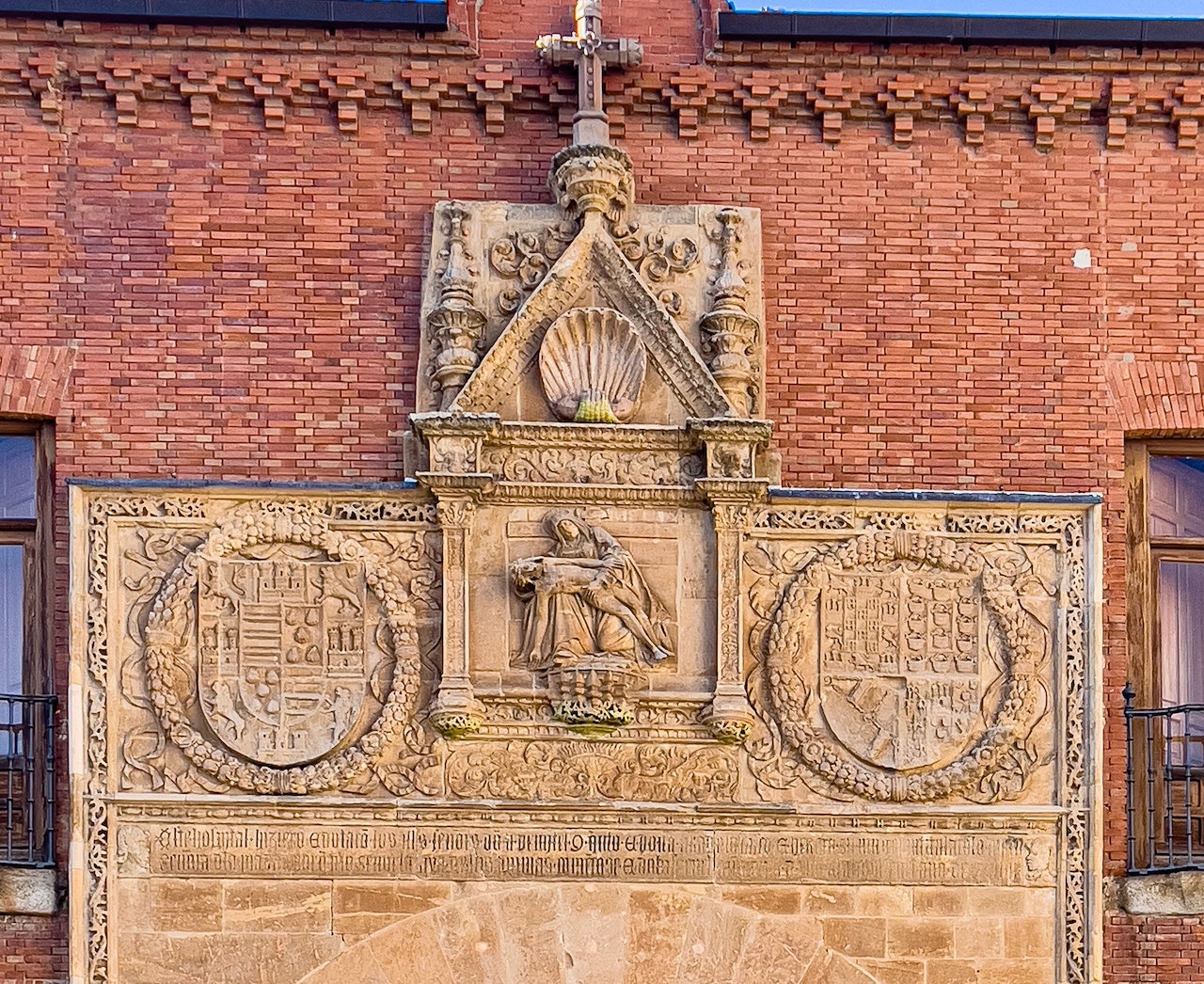
The Way of St. James experienced a decline in popularity during the 16th and 17th centuries due to religious conflicts, political unrest, and the Protestant Reformation. However, interest in the pilgrimage resurfaced in the 20th century, partly due to the efforts of organizations such as the Confraternity of St. James. Today, the Way of St. James has undergone a remarkable revival and attracts pilgrims from all over the world.
UNESCO World Heritage and Cultural Routes:
In 1987, the old town of Santiago de Compostela, including the Cathedral of Santiago, was designated as a UNESCO World Heritage site. In addition, the routes of the Camino de Santiago have been recognized as Cultural Routes by the Council of Europe, highlighting their historical, cultural, and spiritual significance. The Way of St. James continues to captivate and inspire pilgrims, offering a unique blend of history, spirituality, and cultural exchange. Its enduring presence as a pilgrimage route serves as a testament to its profound impact on individuals and its enduring place in the cultural and religious landscape of Europe.
Modern-day pilgrimage on the Way of St. James
Also known as the Camino de Santiago, has evolved to accommodate a diverse range of pilgrims from different backgrounds and motivations. While some individuals choose to embark on the pilgrimage independently, others opt for organized tours or seek the assistance of tour guides. Here's an overview of how modern-day pilgrimages on the Way of St. James typically look:
Independent Pilgrimage:
Many pilgrims choose to undertake the Camino de Santiago independently, walking at their own pace and following their personal itinerary. They may carry their own backpacks, make their own accommodation arrangements, and navigate the route using guidebooks, maps, or mobile apps specifically designed for the Camino.
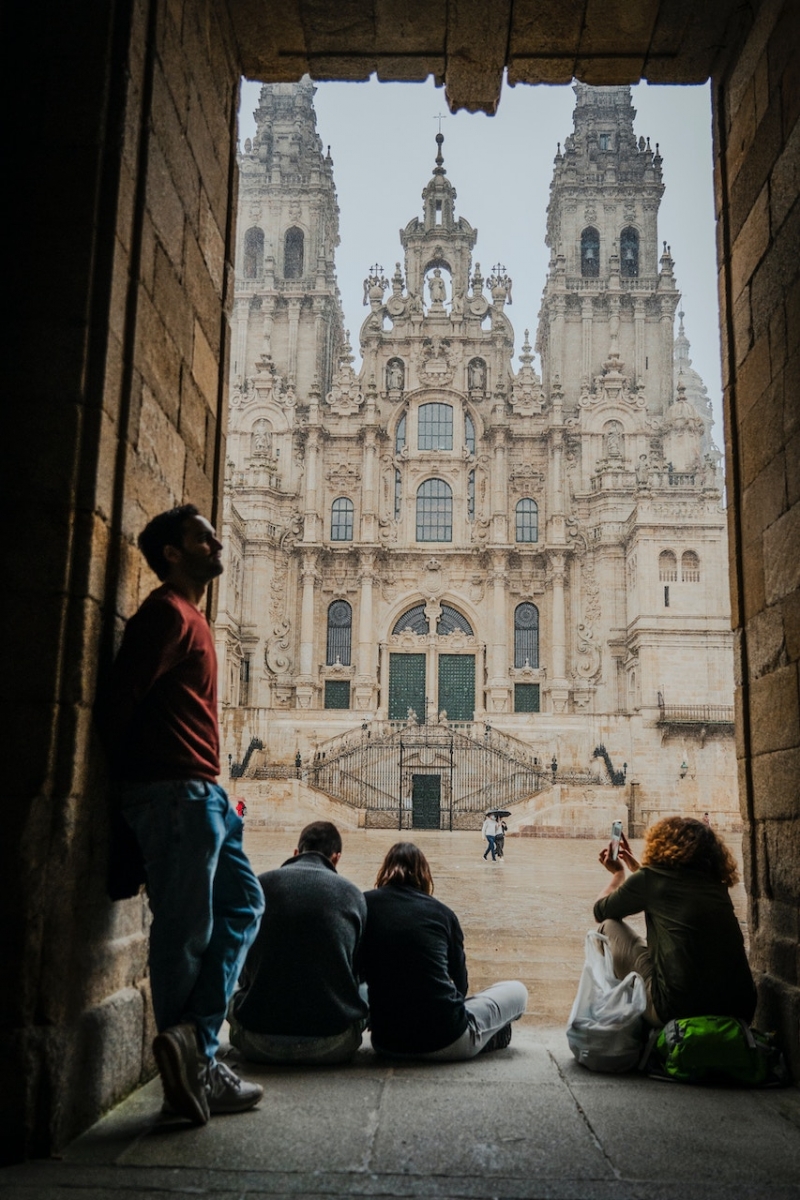
Guided Tours:
Guided tours on the Way of St. James, for example, in Spain, have gained popularity, particularly among those who prefer a structured experience or desire additional support and guidance. Local private tour guides in the cities on the way offer various options, including guided walking or cycling tours, where participants follow an established itinerary led by experienced local tour guides. These tours often include accommodation arrangements, luggage transfers, and additional cultural or historical insights provided by the local tour guides.
Tour Guides from the PRIVATE GUIDE WORLD platform on www.pg.world:
Tour guides play a crucial role in providing information, assistance, and local expertise to pilgrims on the Way of St. James. They may offer insights into the historical and cultural significance of the route, share stories and legends associated with specific sites, provide practical advice on walking distances and daily stages, and offer support in case of any challenges or emergencies along the way. Local tour guides from www.pg.world can enhance the pilgrim's experience by providing a deeper understanding of the pilgrimage and facilitating connections with fellow travelers.
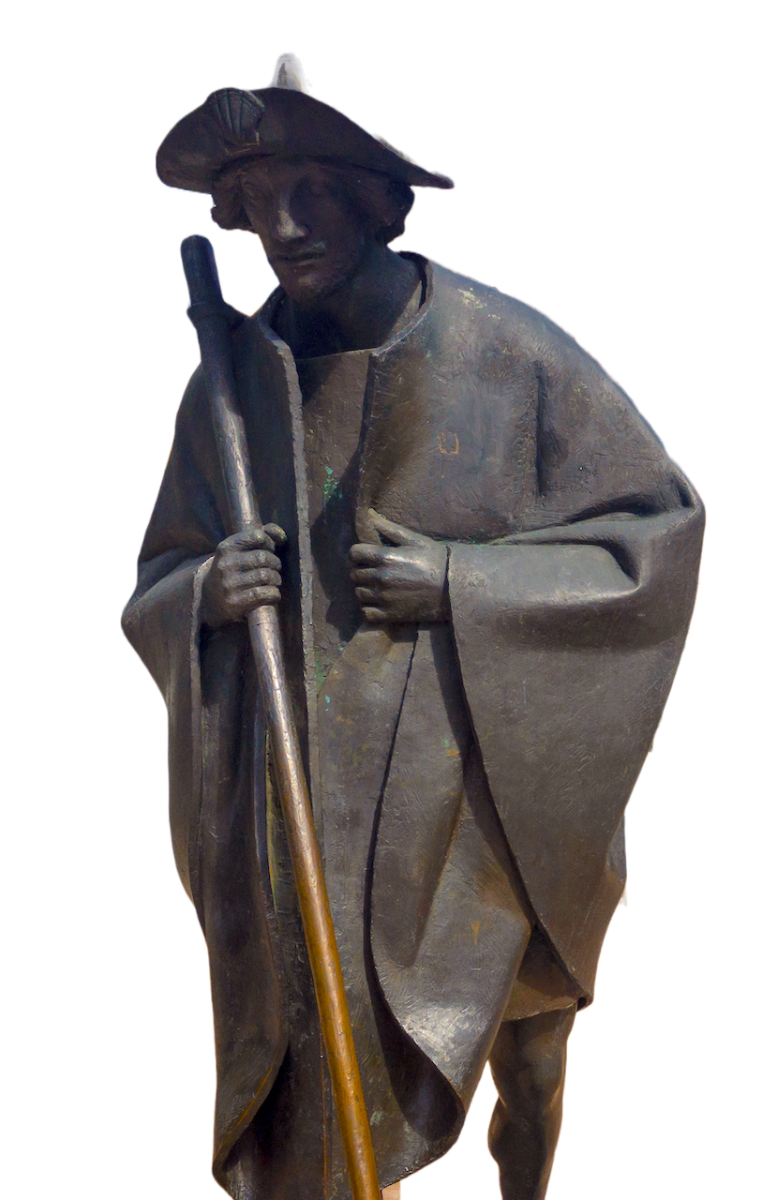
Albergues and Pilgrim Hostels:
Along the Camino, there are numerous albergues (pilgrim hostels) available to provide affordable accommodation for pilgrims. Albergues are typically operated by local organizations or municipalities and offer basic facilities such as dormitory-style bunk beds, communal kitchens, and shared bathrooms. While tour guides may assist in arranging accommodation for their clients, independent pilgrims often rely on the availability of albergues and can make reservations or find accommodation on a first-come, first-served basis.albergues and can make reservations or find accommodation on a first-come, first-served basis.
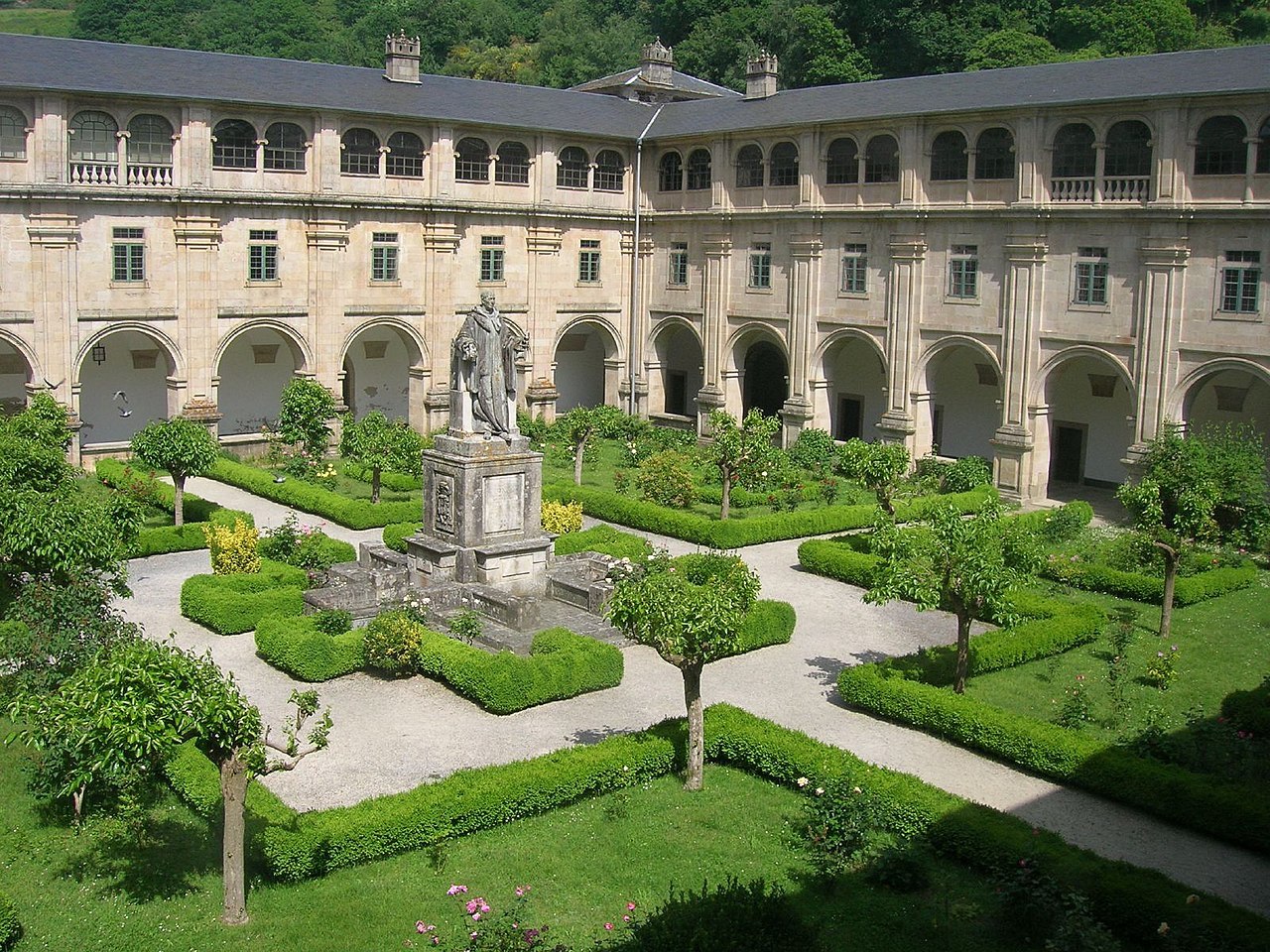
The Monastery of San Xulián de Samos, also known as the Samos Monastery, is a historic and significant religious site located in the town of Samos in the province of Lugo, Galicia, Spain. It is situated along the Camino de Santiago, specifically on the Camino Francés, which is one of the major routes of the Way of St. James. Here is some information about the Monastery of San Xulián de Samos:
History: The monastery's origins date back to the 6th century when it was founded by Saint Martin of Braga. Over the centuries, it underwent various reconstructions and expansions, resulting in a blend of architectural styles, including Romanesque, Gothic, and Baroque. The monastery played a significant role as a center of learning, culture, and hospitality.
Architecture and Design: The Monastery of San Xulián de Samos features an impressive architectural ensemble. Its main façade showcases a combination of Romanesque and Baroque elements. The monastery complex includes a church, cloisters, courtyards, chapels, and other buildings. The grandeur of its architectural design and the serene beauty of its surroundings create a captivating atmosphere for visitors.
Pilgrim Accommodation: One of the notable aspects of the Monastery of San Xulián de Samos is its longstanding tradition of providing shelter and accommodation for pilgrims. Throughout history, it has welcomed weary travelers on their pilgrimage to Santiago de Compostela. Pilgrims can stay at the monastery, experiencing a unique blend of spiritual retreat and cultural immersion.
Cultural and Historical Significance: The monastery holds immense cultural and historical significance. It served as a center of religious and intellectual activity, attracting scholars and artists over the centuries. The monastery's library contains a vast collection of ancient manuscripts and books, making it an important repository of knowledge and preserving the region's cultural heritage.
Pilgrim Services and Hospitality: In addition to providing shelter, the Monastery of San Xulián de Samos offers various services to pilgrims. These include meals, spiritual guidance, and a space for reflection and rest. The atmosphere within the monastery allows pilgrims to connect with their inner selves, find solace, and rejuvenate their spirits.
Tranquil Setting and Natural Surroundings: The monastery is set amidst picturesque landscapes, with lush greenery and rolling hills. Its location near the Sarria River provides a peaceful and serene atmosphere for pilgrims and visitors. The tranquil setting allows for moments of contemplation and a deeper connection with nature.
A visit to the Monastery of San Xulián de Samos provides pilgrims and visitors with a unique opportunity to experience the spiritual traditions and historical legacy of the Camino de Santiago. The monastery's provision of shelter and hospitality adds an extra layer of significance, creating a memorable and enriching experience along the pilgrimage journey.
Pilgrim Support Services:
Infrastructure has developed along the Way of St. James to cater to the needs of modern pilgrims. Services such as luggage transportation, bike rentals, and shuttle services have emerged to make the pilgrimage more accessible and comfortable. These services can be particularly helpful for those traveling with limited mobility or preferring to focus more on the spiritual aspects of the journey rather than logistical concerns.
It's important to note that regardless of whether pilgrims choose to undertake the journey independently or with the support of tour guides, the Way of St. James remains a personal and transformative experience. Pilgrims have the opportunity to connect with the rich history, diverse landscapes, and spiritual traditions along the route, fostering personal reflection, growth, and a sense of community.
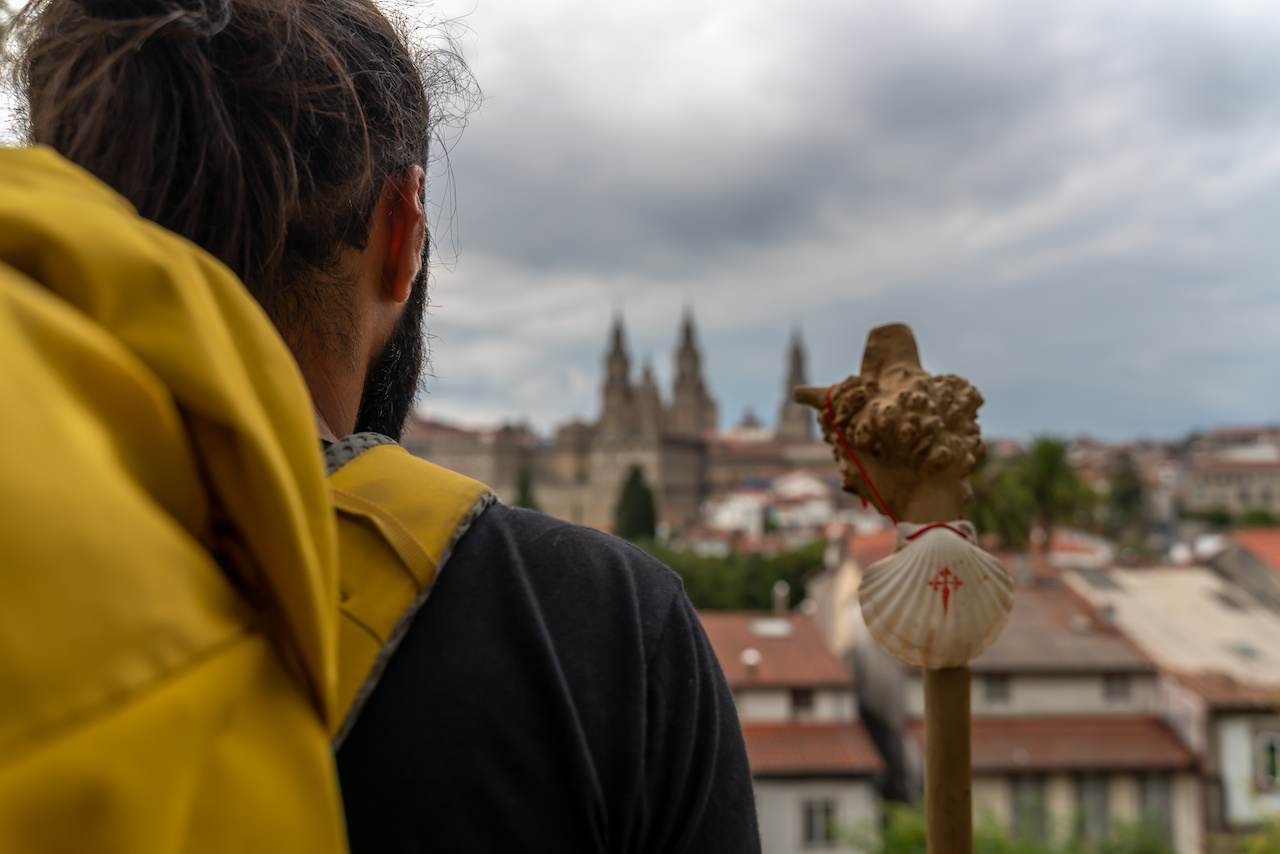
There are many ways
The Way of St. James, or the Camino de Santiago, consists of numerous routes that pilgrims can take to reach Santiago de Compostela. While there are many variations and alternative paths, here are some of the main and most well-known routes:
Camino Francés (French Way):
The Camino Francés is the most popular and traditional route, starting in St. Jean Pied de Port, France, and spanning approximately 800 kilometers (500 miles) to Santiago de Compostela. It crosses the Pyrenees, passes through cities like Pamplona, Logroño, Burgos, and León, and offers a diverse range of landscapes and cultural experiences.

Camino Portugués (Portuguese Way):
The Camino Portugués starts in various locations in Portugal, such as Lisbon or Porto, and follows the western coast of the Iberian Peninsula. It enters Spain and continues through cities like Pontevedra and Padron, eventually joining the Camino Francés near Santiago de Compostela. This route is known for its coastal beauty and rich cultural heritage.
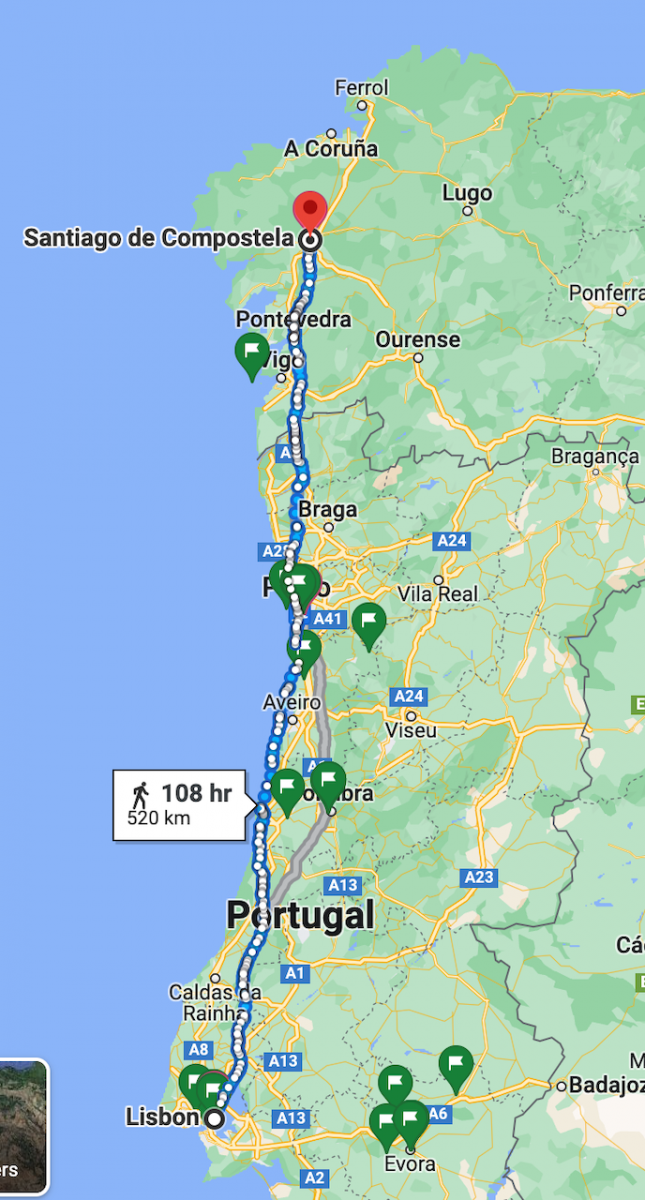
Camino del Norte (Northern Way):
The Camino del Norte follows the northern coast of Spain, starting in Irún or San Sebastián and passing through cities like Bilbao, Santander, and Oviedo. This route offers stunning coastal scenery, mountainous landscapes, and encounters with vibrant Basque, Cantabrian, and Asturian cultures.

Via de la Plata (Silver Route):
The Via de la Plata starts in Seville or Mérida in southern Spain and extends northward, eventually joining the Camino Francés in Astorga. This route covers a significant distance, approximately 1,000 kilometers (620 miles), and showcases the historical and cultural heritage of southern and western Spain.Mérida in southern Spain and extends northward, eventually joining the Camino Francés in Astorga. This route covers a significant distance, approximately 1,000 kilometers (620 miles), and showcases the historical and cultural heritage of southern and western Spain.
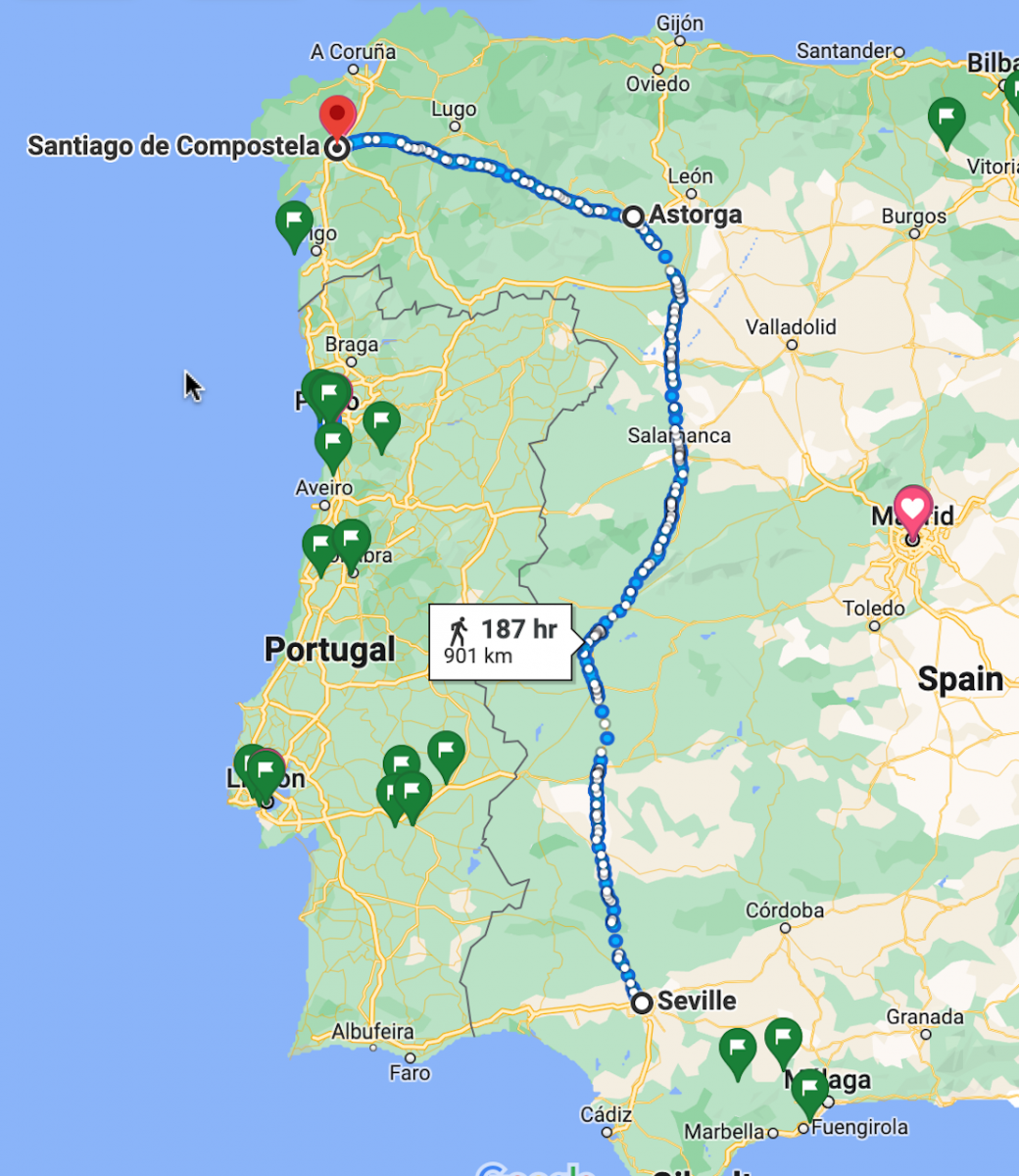
Camino Primitivo (Original Way):
The Camino Primitivo is believed to be the original route followed by the first pilgrims to Santiago. It starts in Oviedo, northern Spain, and leads through picturesque landscapes of Asturias and Galicia, eventually joining the Camino Francés in Melide.
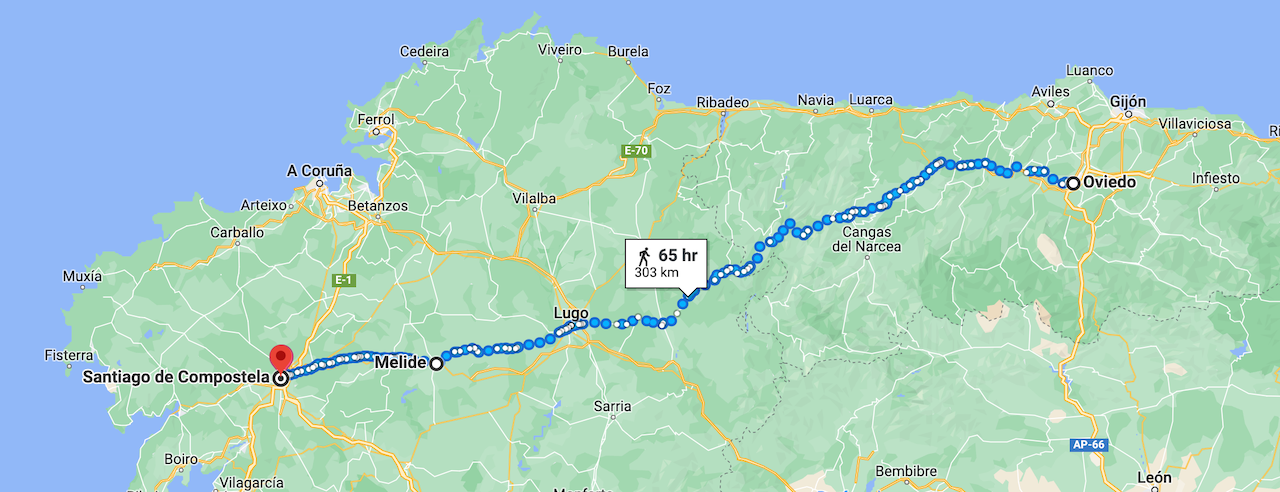
Camino Inglés (English Way):
The Camino Inglés historically served as a route for pilgrims arriving by boat from England and Ireland. It starts in Ferrol or A Coruña, both in Galicia, and provides a shorter distance to Santiago de Compostela.
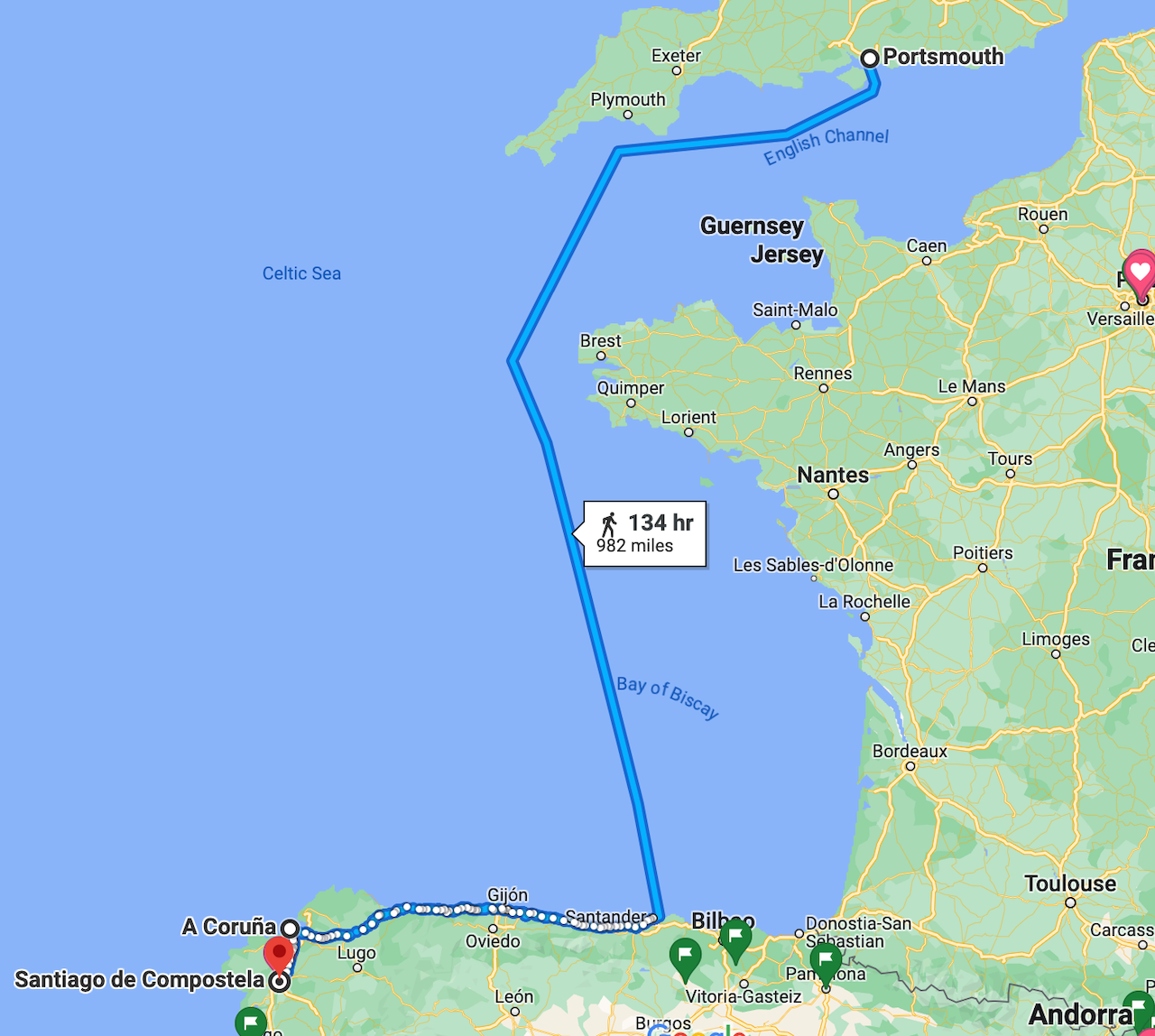
These are just a few examples of the main routes of the Camino de Santiago. Each route offers its own distinct landscapes, cultural experiences, and historical significance, providing pilgrims with a variety of choices and the opportunity to explore different regions of Spain and beyond.
The countries and cities on the way
The Way of St. James, or the Camino de Santiago, passes through several countries and cities along its various routes. Here are some of the countries and notable cities that pilgrims can visit:
Spain:
The majority of the Camino routes traverse Spain, offering pilgrims the opportunity to explore its diverse regions and cities. Some of the notable cities and towns include
- Pamplona: The starting point of the Camino Francés in Spain, known for its annual Running of the Bulls festival.
- Logroño: The capital of the La Rioja region, renowned for its wine production.
- Burgos: A historic city with a stunning cathedral and medieval architecture.
- León: Known for its impressive Gothic cathedral and rich cultural heritage.
- Ponferrada: Home to the Templar Castle and a stop along the Camino Francés.
- Santiago de Compostela: The final destination of the pilgrimage, housing the magnificent Cathedral of Santiago de Compostela, which holds the remains of St. James.
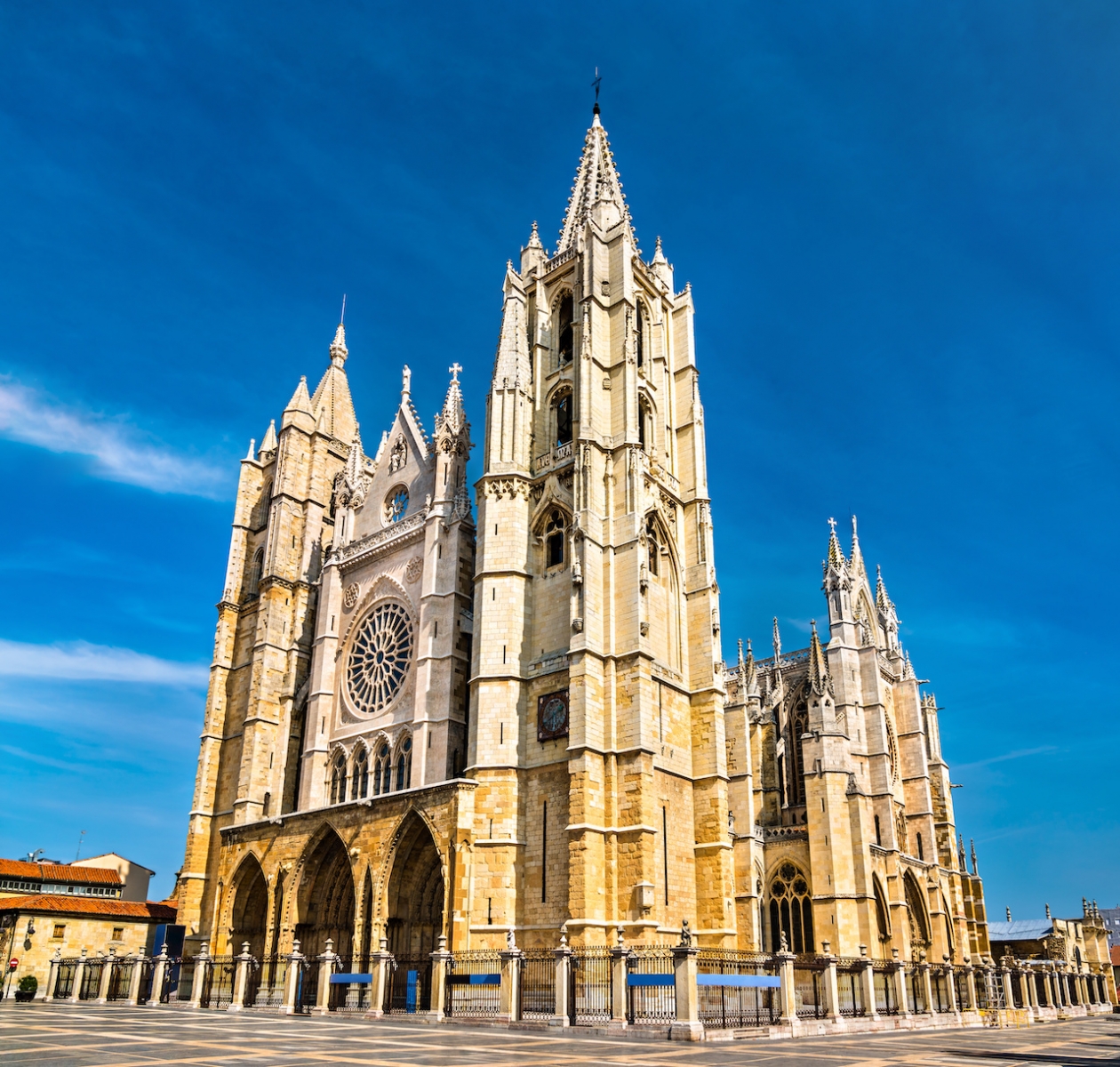
The Leon Cathedral of Santa Maria de Regla, commonly known as the Leon Cathedral or Catedral de León, is a magnificent Gothic cathedral located in the city of León, in the province of León, Spain. It is widely regarded as one of the most important and beautiful cathedrals in Spain. Here is some information about the Leon Cathedral:
History: Construction of the Leon Cathedral began in the 13th century, following the French Gothic architectural style. It was built on the site of an earlier Romanesque cathedral. The construction took several centuries to complete, resulting in a blend of architectural styles, including French Gothic, Flamboyant Gothic, and Renaissance elements.
Architecture and Design: The Leon Cathedral is celebrated for its stunning architectural features. It boasts intricate ornamentation, intricate stained glass windows, towering spires, and a grandiose interior. The cathedral's façade is adorned with numerous sculptures, including biblical figures, saints, and intricate reliefs.
Windows and Stained Glass: One of the highlights of the Leon Cathedral is its exceptional collection of stained glass windows. The cathedral houses some of the most exquisite and well-preserved medieval stained glass in Europe. The windows depict religious scenes, biblical stories, and intricate geometric patterns, creating a mesmerizing play of light inside the cathedral.
Basilica and Royal Pantheon: Within the cathedral complex, there is a smaller basilica dedicated to San Isidoro, which is a significant pilgrimage site. It houses the Royal Pantheon, the final resting place of several Spanish monarchs. The Pantheon is renowned for its stunning frescoes and richly decorated tombs.
UNESCO World Heritage: The Leon Cathedral, along with other buildings in the city of León, is a designated UNESCO World Heritage Site. It is recognized for its architectural and historical importance, representing a pinnacle of Spanish Gothic architecture and its influence in the region.
Pilgrimage Connection: León is a significant stop along the Camino de Santiago, specifically on the Camino Francés. Many pilgrims on the Way of St. James pass through León and have the opportunity to visit the cathedral. The cathedral's impressive architecture and spiritual ambiance make it a meaningful place for pilgrims on their journey.
Visiting the Leon Cathedral offers a captivating experience, immersing visitors in the grandeur of its architecture, the beauty of its stained glass windows, and the spiritual ambiance of the sacred space. It stands as a testament to the skill and craftsmanship of its builders and is a treasured cultural and historical landmark in the city of León and the wider region of Castile and León.
France:
The Camino Francés begins in St. Jean Pied de Port, France, at the foothills of the Pyrenees. While pilgrims mainly pass through France on the first day of the journey, the town of St. Jean Pied de Port itself is a charming destination worth exploring.
Portugal:
The Camino Portugués starts in Portugal, allowing pilgrims to discover the country's cultural and historical treasures before crossing into Spain. Notable cities and towns include:
- Lisbon: The capital of Portugal, offering a vibrant mix of history, culture, and stunning architecture.
- Porto: Known for its port wine production, picturesque riverside, and historic center, a UNESCO World Heritage site.
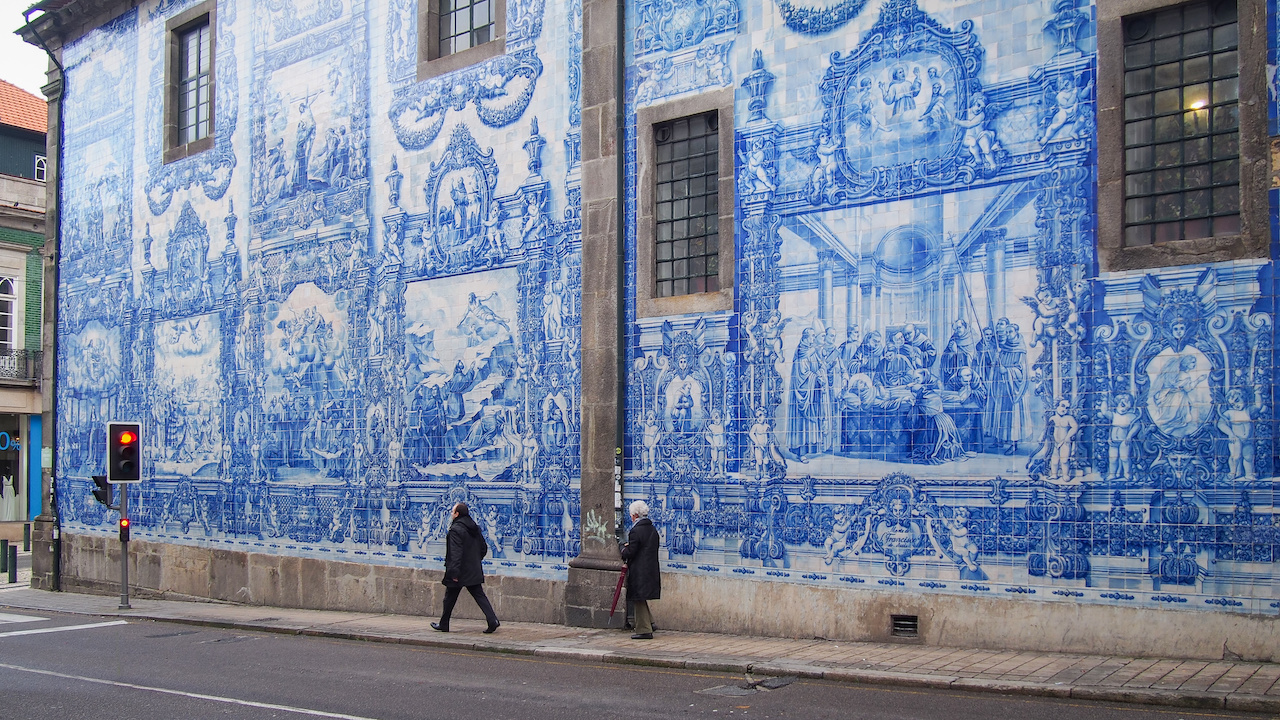
The pavement next to the wall of the Chapel of Souls (Capela das Almas) in Porto, Portugal, is adorned with beautiful azulejos, which are traditional Portuguese ceramic tiles. These vibrant and decorative tiles are an iconic feature of Portuguese culture and can be found throughout the country. Here is some information about the azulejo decoration on the pavement next to the wall of the Chapel of Souls:
History and Significance: The use of azulejos in Portugal dates back to the 15th century when they were introduced by the Moors. These painted ceramic tiles became an integral part of Portuguese architectural and artistic expression. The azulejo decoration on the pavement next to the Chapel of Souls reflects this rich heritage and the long-standing tradition of tilework in Portugal.
Design and Patterns: The azulejos on the pavement display intricate patterns and designs. They often depict religious scenes, historical events, or cultural motifs. The color palette ranges from vibrant blues, yellows, and greens to earthy tones, creating a visually striking and harmonious composition.
Symbolism and Religious Themes: The Chapel of Souls itself is a religious landmark, and the azulejo decoration on its adjacent pavement often carries religious symbolism. The tiles may depict saints, biblical figures, or scenes from religious stories, serving as a visual representation of faith and spirituality.
Preservation and Restoration: The preservation and restoration of azulejos are of great importance in Portugal. The pavement's azulejos are carefully maintained and protected to ensure their longevity and to showcase the historical and cultural significance of this traditional art form.
Cultural Identity and Tourist Attraction: The presence of azulejos in Portugal, including the decorative pavement next to the Chapel of Souls, is a source of pride and a significant element of the country's cultural identity. The vibrant and eye-catching tiles add charm and character to the streetscape and contribute to the overall beauty of the city of Porto. The azulejo pavement is also a popular tourist attraction, drawing visitors who admire the craftsmanship and artistic expression of this unique Portuguese art form.
Visitors to Porto, specifically those exploring the area around the Chapel of Souls, can enjoy the visually stunning azulejo decoration on the pavement. It provides a glimpse into the rich cultural heritage of Portugal, showcasing the country's artistic traditions and religious symbolism. The intricate and colorful tiles create an enchanting and memorable experience for locals and tourists alike, adding to the allure of Porto's architectural and artistic treasures.
Other Countries:
Depending on the chosen route and any alternative paths, pilgrims may pass through or near other countries. For example
- The Camino del Norte hugs the northern coast of Spain, providing glimpses of the Bay of Biscay and occasionally coming close to the border with France.
- The Via de la Plata passes through or near cities such as Mérida and Cáceres with Trujillo Castle in Spain before reaching Santiago de Compostela.
It's important to note that while the primary focus of the pilgrimage is on the cities and towns along the Camino de Santiago, there are also countless smaller villages and scenic areas that offer unique experiences and encounters with local culture and traditions.
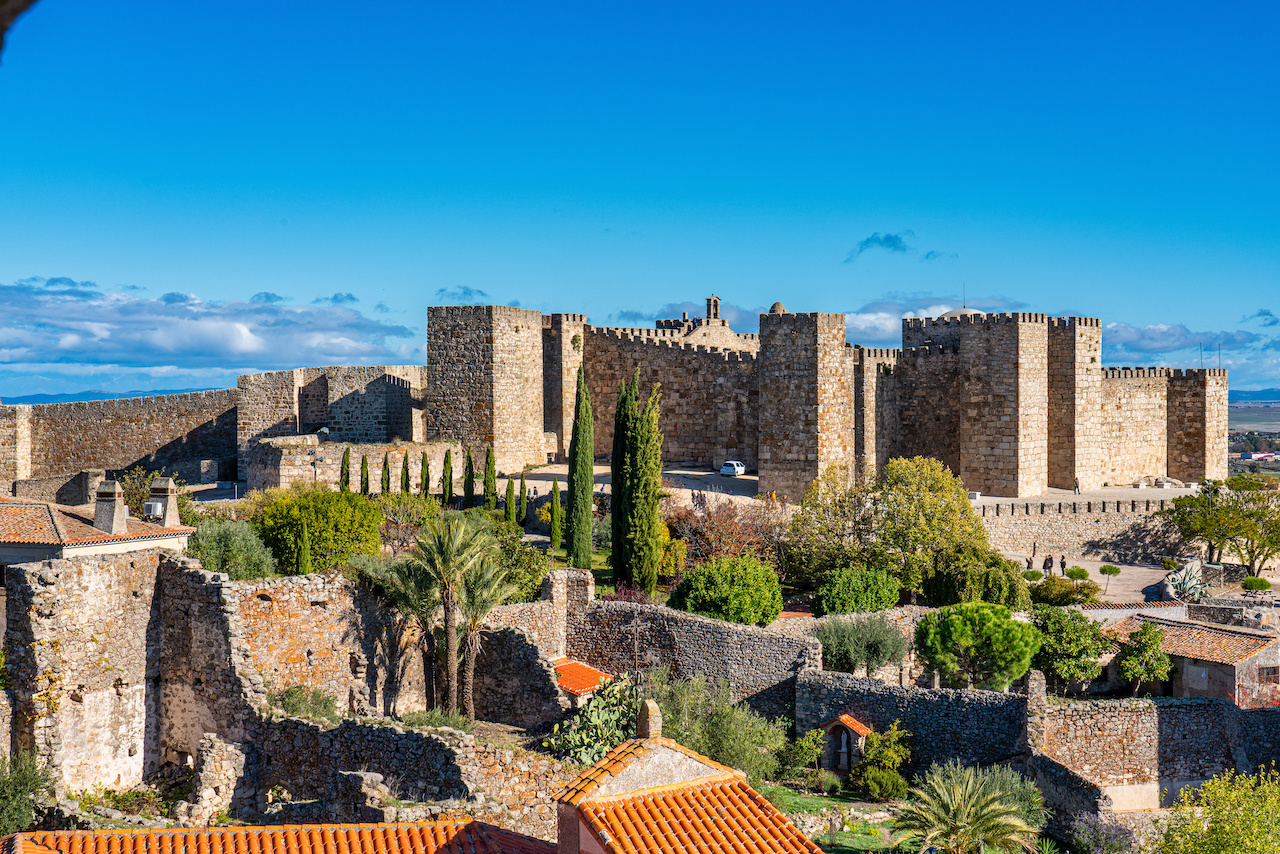
Trujillo Castle, also known as the Castle of Trujillo, is a historic fortress located in the town of Trujillo, in the region of Extremadura, Spain. It is a prominent landmark that has witnessed centuries of history and stands as a testament to the region's rich heritage. Here is some information about Trujillo Castle:
History and Arab Origins: Trujillo Castle has its roots in the Arab period of Spain's history. It was originally built as an Alcazaba, which is a fortified complex commonly used as a residence for Arab rulers. The castle was strategically positioned on a hill, offering a vantage point for overseeing the surrounding area.
Architecture and Design: The castle underwent numerous transformations and expansions over the centuries, resulting in a blend of architectural styles. It showcases a mix of Moorish, Romanesque, Gothic, and Renaissance elements. The castle's layout includes fortified walls, towers, battlements, and a central courtyard. It is a prime example of medieval military architecture.
Historic Significance: Trujillo Castle played a significant role in the region's history. It served as a stronghold for various ruling dynasties, including the Moors and the Christian kings. It witnessed conflicts, battles, and changing political landscapes, reflecting the tumultuous history of the region.
Cultural and Tourist Attraction: Today, Trujillo Castle is a popular tourist attraction, drawing visitors from around the world. The castle's well-preserved architecture, commanding views, and historical significance make it a captivating destination. Visitors can explore the castle's interior, walk along its ramparts, and admire the panoramic vistas of Trujillo and the surrounding countryside.
Museo de la Coria: Within the castle complex, there is the Museo de la Coria, a museum that showcases archaeological artifacts and exhibits related to the history of Trujillo and the region. It provides visitors with a deeper understanding of the castle's historical context and the cultural heritage of Extremadura.
Cultural Events and Festivals: Trujillo Castle serves as a venue for various cultural events and festivals throughout the year. It hosts concerts, theatrical performances, and historical reenactments, providing visitors with a unique opportunity to immerse themselves in the vibrant cultural scene of Trujillo.
A visit to Trujillo Castle offers a captivating journey through history, allowing visitors to delve into the medieval past of the region. The castle's imposing architecture, commanding presence, and panoramic views create an unforgettable experience. It stands as a testament to the strength, resilience, and rich cultural heritage of Trujillo and the wider region of Extremadura, providing a glimpse into Spain's storied past.
Accommodation on the ways
Finding accommodation along the Way of St. James can generally be manageable, although availability can vary depending on the season and the popularity of the route. Here's what you can expect regarding accommodation options in villages along the Camino de Santiago:
Albergues (Pilgrim Hostels):
Albergues are the most common and traditional form of accommodation for pilgrims. They are typically operated by local organizations, municipalities, or private individuals and offer dormitory-style accommodations with shared facilities such as bathrooms, kitchens, and common areas. Albergues are often affordable and provide a communal atmosphere, allowing pilgrims to connect with fellow travelers. It's advisable to have a pilgrim's credential (pilgrim's passport) to access certain albergues.albergues.
Private Hostels and Guesthouses:
In addition to albergues, many villages along the Camino offer private hostels and guesthouses that provide more varied accommodation options, including private rooms and sometimes additional amenities like private bathrooms. Private accommodations tend to be slightly more expensive than albergues but offer greater comfort and privacy.albergues, many villages along the Camino offer private hostels and guesthouses that provide more varied accommodation options, including private rooms and sometimes additional amenities like private bathrooms. Private accommodations tend to be slightly more expensive than albergues but offer greater comfort and privacy.
 Hotels and Bed and Breakfasts:
Hotels and Bed and Breakfasts:
In larger towns and cities along the Camino, you'll find a range of hotels and bed and breakfast establishments that cater to pilgrims. These accommodations offer more amenities and comfort, but they may also be pricier than albergues and private hostels.albergues and private hostels.
Rural Lodgings and Farmhouses:
Some villages along the Camino offer unique accommodations in rural settings, such as country houses, farm stays, and rural lodgings. These options provide a chance to experience the local rural lifestyle and enjoy the natural surroundings. They are often smaller and may require advance booking.
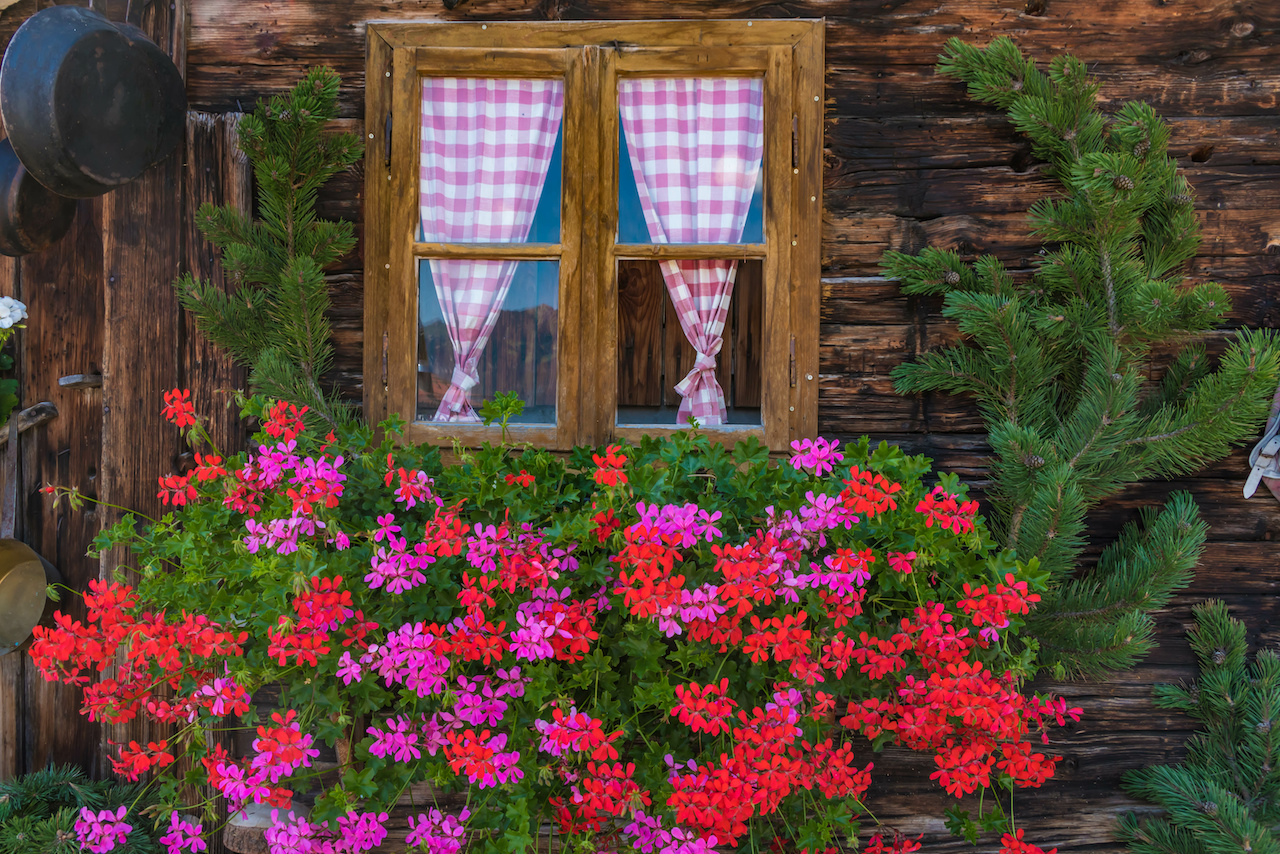
It's important to note that during peak pilgrimage seasons, such as the summer months, accommodation along popular routes can become crowded, and it may be more challenging to find available beds, especially in albergues. To secure a place to stay, it is recommended to start your search early in the day, arrive at your desired destination relatively early, or consider making advance reservations in certain cases. Many villages along the Camino are prepared to accommodate pilgrims, but it's always a good idea to have a backup plan or alternative options in case your preferred accommodation is full. Consulting guidebooks, online resources, and local pilgrim information centers can provide up-to-date information on available accommodations in each village or town.albergues. To secure a place to stay, it is recommended to start your search early in the day, arrive at your desired destination relatively early, or consider making advance reservations in certain cases. Many villages along the Camino are prepared to accommodate pilgrims, but it's always a good idea to have a backup plan or alternative options in case your preferred accommodation is full. Consulting guidebooks, online resources, and local pilgrim information centers can provide up-to-date information on available accommodations in each village or town.
Credential or pilgrim's passport
The Credential, also known as the pilgrim's passport, is an essential document for pilgrims on the Way of St. James. Here's some information about the Credential and its significance:

Purpose of the Credencial: The Credencial serves multiple purposes along the Camino de Santiago. It acts as a form of identification for pilgrims, establishes their status as participants in the pilgrimage, and allows access to certain pilgrim-specific services and accommodations. It also serves as a record of the journey, as pilgrims can collect stamps (sellos) from churches, hostels, and other designated locations along the way.Credencial: The Credencial serves multiple purposes along the Camino de Santiago. It acts as a form of identification for pilgrims, establishes their status as participants in the pilgrimage, and allows access to certain pilgrim-specific services and accommodations. It also serves as a record of the journey, as pilgrims can collect stamps (sellos) from churches, hostels, and other designated locations along the way.

Obtaining the Credential: The Credential can be obtained in various ways. Pilgrims can obtain it in their home country through authorized organizations, religious associations, or pilgrimage offices. It can also be obtained at the starting point of the pilgrimage, such as the Cathedral of Santiago de Compostela or local pilgrim information centers. Some albergues and accommodation establishments may also provide the Credential upon arrival.Compostela or local pilgrim information centers. Some albergues and accommodation establishments may also provide the Credential upon arrival.
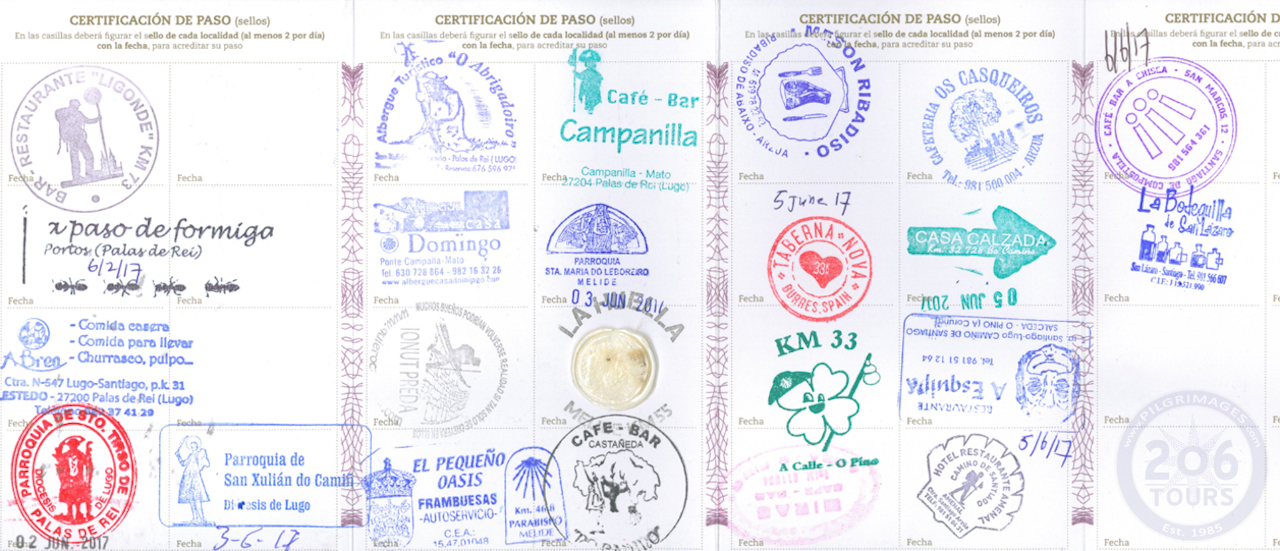
Stamps (Sellos): As pilgrims progress along the Camino, they can collect stamps or sellos in their Credencial as a way to document their journey. Stamps can be obtained from churches, cathedrals, albergues, tourist offices, cafes, and other designated places. These stamps serve as a memento of the pilgrimage and can be used to obtain the Compostela certificate upon arrival in Santiago de Compostela.Sellos): As pilgrims progress along the Camino, they can collect stamps or sellos in their Credencial as a way to document their journey. Stamps can be obtained from churches, cathedrals, albergues, tourist offices, cafes, and other designated places. These stamps serve as a memento of the pilgrimage and can be used to obtain the Compostela certificate upon arrival in Santiago de Compostela.
Compostela Certificate: Upon reaching Santiago de Compostela, pilgrims can present their completed Credential with a minimum number of stamps (typically the last 100 kilometers walked or the last 200 kilometers cycled) to the Pilgrim's Office (Oficina del Peregrino) in order to receive the Compostela certificate. The Compostela is an official certificate issued in Latin, recognizing the completion of the pilgrimage to the tomb of St. James.Compostela, pilgrims can present their completed Credential with a minimum number of stamps (typically the last 100 kilometers walked or the last 200 kilometers cycled) to the Pilgrim's Office (Oficina del Peregrino) in order to receive the Compostela certificate. The Compostela is an official certificate issued in Latin, recognizing the completion of the pilgrimage to the tomb of St. James.

Spiritual and Practical Significance: The Credential holds spiritual significance for many pilgrims, symbolizing their commitment and participation in the Camino de Santiago. It also serves practical purposes, such as granting access to certain pilgrim-specific accommodations (e.g., albergues) and discounts at designated establishments.albergues) and discounts at designated establishments.
The Credential is not only a practical document but also a cherished souvenir that represents the pilgrim's personal journey and experiences along the Way of St. James. It is recommended to keep the Credential safe throughout the pilgrimage and to protect it from damage, as it holds memories and serves as a tangible reminder of the pilgrimage undertaken.
And finally - Santiago de Compostela
When visiting Santiago de Compostela with a local private tour guide, you have the opportunity to explore the city's rich history, architecture, and cultural heritage. Here are some highlights and places to consider visiting:
Santiago de Compostela Cathedral: The Santiago de Compostela Cathedral, also known as the Cathedral of St. James, is the most important site in the city. Its grand facade, Romanesque and Baroque architectural elements, and the Portico de la Gloria make it a must-visit attraction. The tour guide can provide historical and cultural insights into the cathedral and its significance as the final destination of the Camino de Santiago.
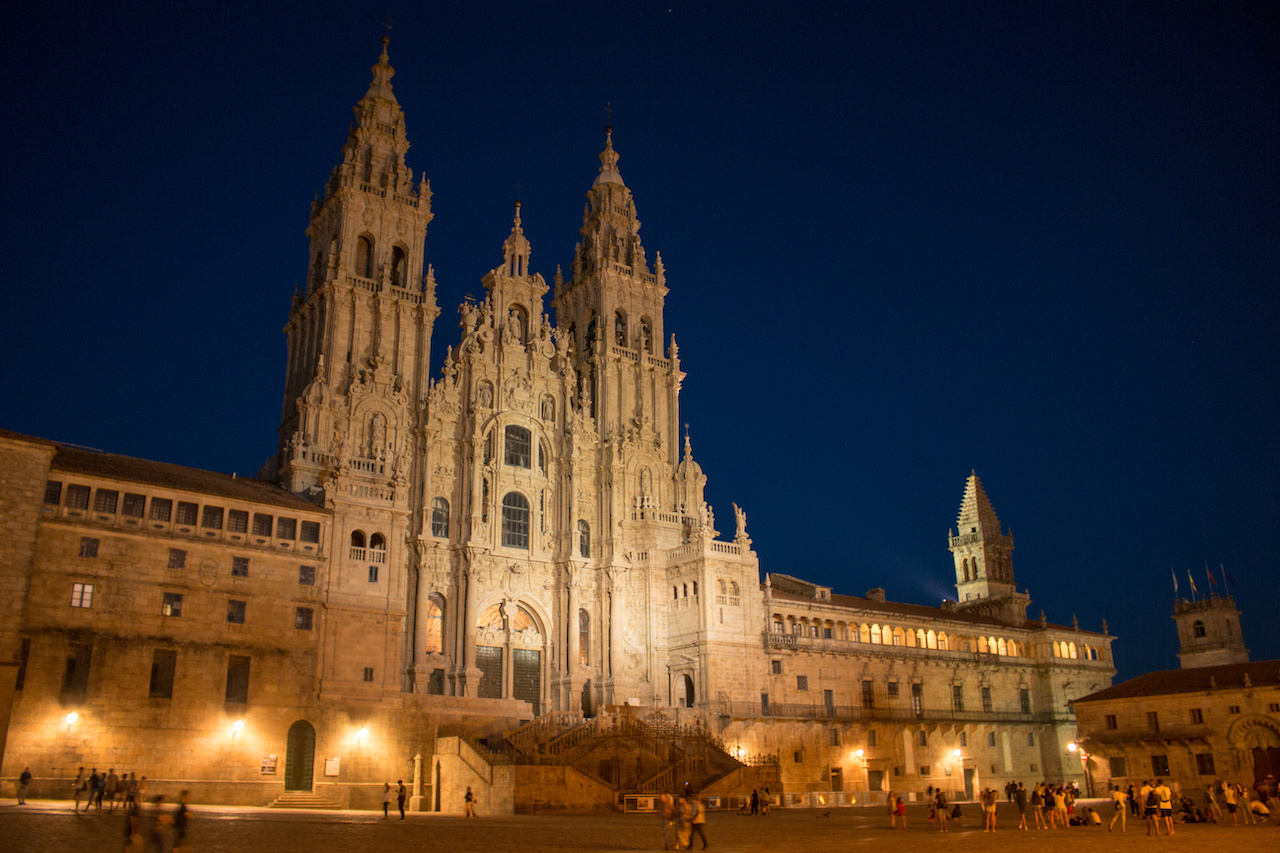
The Santiago de Compostela Cathedral, also known as the Cathedral of Santiago de Compostela or Catedral de Santiago, is a magnificent Romanesque and Baroque-style cathedral located in the city of Santiago de Compostela, in the region of Galicia, Spain. It is the ultimate destination of the Way of St. James pilgrimage and holds great religious and historical significance. Here is some information about the Santiago de Compostela Cathedral:
History: The construction of the cathedral began in the 11th century and continued over several centuries. It was built on the site where the remains of Saint James the Greater, one of the twelve apostles of Jesus, are believed to be buried. The cathedral's rich history is intertwined with the origins and development of the Way of St. James pilgrimage.
Architecture and Design: The Santiago de Compostela Cathedral showcases a mix of architectural styles, predominantly Romanesque and Baroque. Its main façade features intricate stone carvings and sculptures, depicting biblical scenes, saints, and symbolic figures. The cathedral's interior is adorned with beautiful chapels, altars, and a stunning golden-baroque high altar.
Portico of Glory: One of the most notable features of the cathedral is the Portico of Glory, located at the western entrance. This masterpiece of Romanesque sculpture features a multitude of intricately carved figures, including the image of Christ in Majesty. The Portico of Glory is considered a masterpiece of medieval art and attracts visitors from around the world.
Botafumeiro: The cathedral is renowned for its Botafumeiro, a large thurible or incense burner. During special religious occasions, the Botafumeiro is swung across the nave, filling the cathedral with fragrant incense and creating a spectacular sight. The swinging of the Botafumeiro is a symbol of purification and a cherished tradition of the cathedral.
Pilgrimage Destination: The Santiago de Compostela Cathedral is the final destination of the Way of St. James pilgrimage, attracting hundreds of thousands of pilgrims each year. Pilgrims traditionally gather in front of the cathedral to receive the Compostela, a certificate of completion, after completing their pilgrimage. The cathedral's presence as a pilgrimage site has shaped the city of Santiago de Compostela and its cultural identity.
Cultural and Historical Significance: The cathedral holds immense cultural, religious, and historical significance. It has been designated a UNESCO World Heritage Site and serves as an important symbol of Galician identity. The cathedral's architecture, art, and spiritual atmosphere offer visitors a profound connection to centuries of history and devotion.
Visiting the Santiago de Compostela Cathedral provides a transformative experience, whether as a pilgrim completing the Way of St. James or as a curious traveler exploring its architectural splendor. The cathedral stands as a testament to faith, human accomplishment, and the enduring power of pilgrimage, attracting visitors from all walks of life who seek spiritual nourishment and a deeper connection with history and culture.
Plaza del Obradoiro: The main square of Santiago de Compostela, Plaza del Obradoiro, is a bustling area surrounded by impressive buildings. Here, you can admire the grandeur of the cathedral, the Palacio de Raxoi, which houses the city council, and the Hostal de los Reyes Católicos, a historic Parador (luxury hotel).
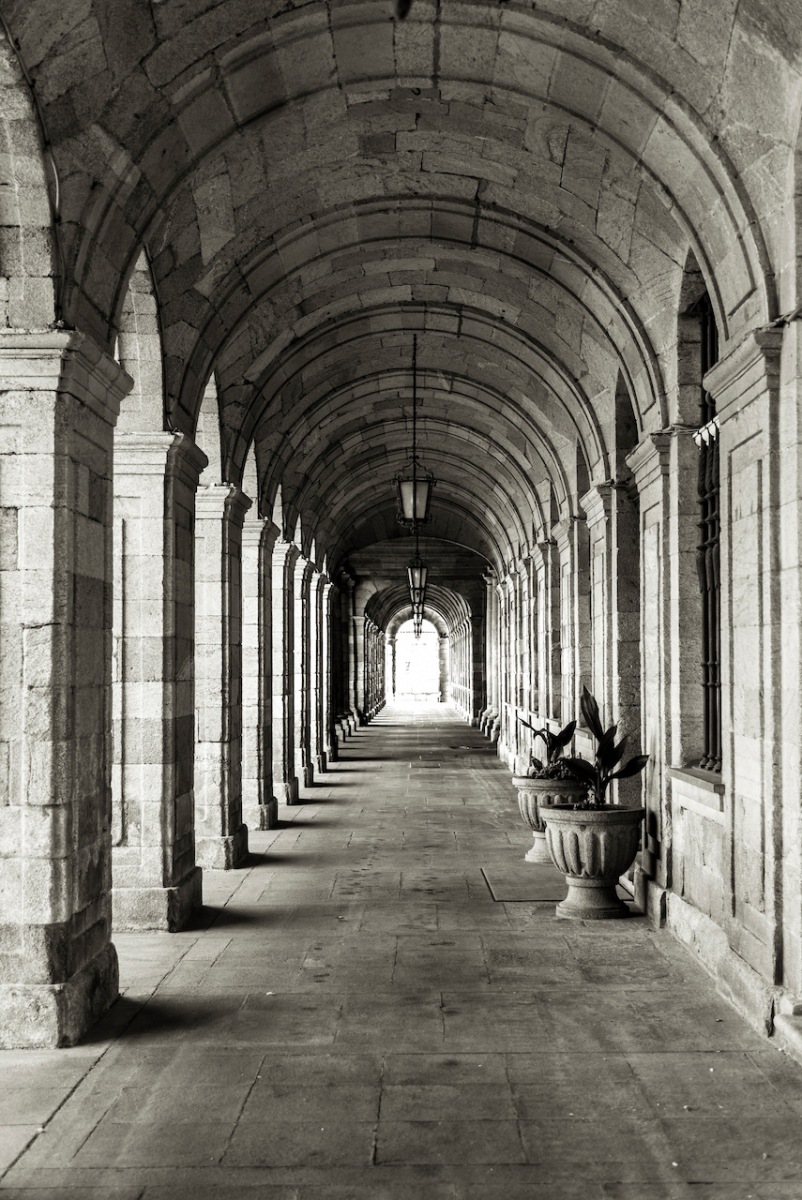
The Arcos en la Plaza del Obradoiro, or Arches in the Plaza del Obradoiro, are a prominent architectural feature located in the heart of Santiago de Compostela, Spain. Situated in the Plaza del Obradoiro, which is the main square in front of the Santiago de Compostela Cathedral, these arches add to the grandeur and historical significance of the city. Here is some information about the Arcos en la Plaza del Obradoiro:
Location and Design: The Arcos en la Plaza del Obradoiro consist of a series of arches that span across the Plaza del Obradoiro. The arches are situated at the western entrance of the square, forming a visually impressive gateway to the Santiago de Compostela Cathedral. They serve as a transition point between the urban environment and the sacred space of the cathedral.
Symbolism and Significance: The arches hold symbolic importance in the context of the Santiago de Compostela pilgrimage. As pilgrims reach the Plaza del Obradoiro, passing under the arches represents their final approach to the cathedral, marking the culmination of their arduous journey. The arches act as a symbol of completion, accomplishment, and the fulfillment of spiritual aspirations.
Architectural Style: The arches exhibit a mix of architectural styles, including Baroque and Neoclassical elements. They harmoniously blend with the surrounding buildings and the grandeur of the cathedral. The architectural details and ornamentation on the arches reflect the artistic craftsmanship of the time and contribute to the overall aesthetic appeal of the plaza.
Gathering Place and Cultural Events: The Plaza del Obradoiro, framed by the arches, serves as a gathering place for locals and visitors alike. The open space hosts various cultural events, religious processions, and celebrations throughout the year, adding to the vibrant atmosphere of Santiago de Compostela. The arches provide a picturesque backdrop for these festivities.
Scenic Views: From the Plaza del Obradoiro, the arches offer stunning views of the Santiago de Compostela Cathedral and its surrounding architectural marvels. The sight of the cathedral, framed by the arches, creates an iconic image that has become synonymous with Santiago de Compostela. It is a popular spot for photographers and tourists seeking to capture the beauty and essence of the city.
The Arcos en la Plaza del Obradoiro serve as a gateway to the spiritual and cultural riches of Santiago de Compostela. Their presence adds a sense of grandeur, symbolism, and historical significance to the Plaza del Obradoiro, making it an unforgettable destination for pilgrims and visitors. Standing beneath the arches, one can feel the weight of centuries of history and the transformative power of the pilgrimage to the Santiago de Compostela Cathedral.
Old Town (Casco Viejo): Explore the narrow streets and charming squares of Santiago's Old Town, a UNESCO World Heritage site. The tour guide can lead you through picturesque alleys, pointing out architectural gems, local shops, and traditional Galician restaurants. Don't miss the vibrant Mercado de Abastos (central market), where you can find fresh produce, seafood, and regional specialties.
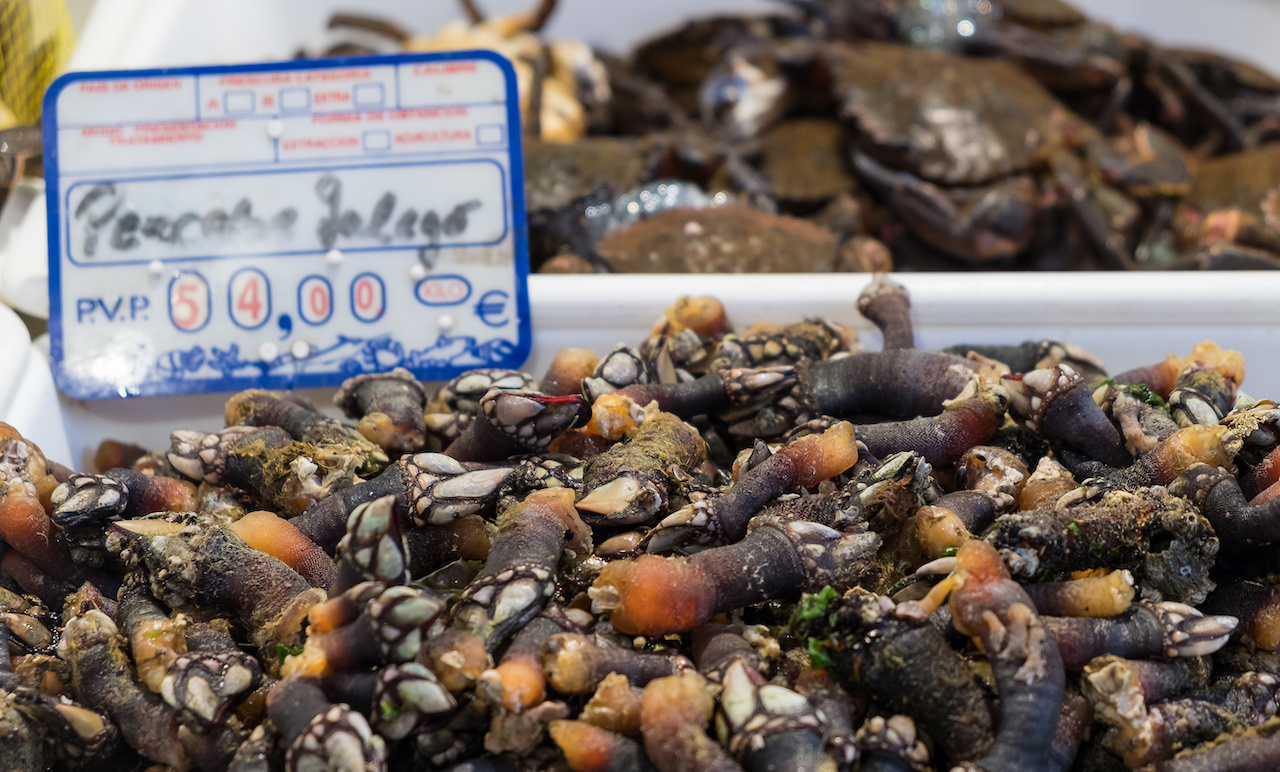
Percebe gallego, also known as gooseneck barnacles or Galician barnacles, is a highly prized seafood delicacy found along the rocky coastlines of Galicia, in the northwestern region of Spain. Here is some information about percebe gallego:
Appearance and Harvesting: Percebes are small crustaceans that live attached to rocks and cliffs in the intertidal zone, where the land meets the sea. They have a unique appearance, resembling tiny dinosaur-like creatures with a long, curved neck and a black or dark brown shell. Harvesting percebes is a challenging and dangerous task, as it requires skilled harvesters to climb treacherous coastal cliffs and gather them by hand.
Culinary Delicacy: Percebe gallego is highly regarded for its exquisite flavor and delicate texture. It is considered a culinary delicacy in Galicia and is often enjoyed as a special treat or served in high-end seafood restaurants. Percebes are typically prepared simply, boiled in seawater and served on a platter, allowing the natural brininess and sweet taste of the meat to shine.
Unique Flavor Profile: The meat of percebe is succulent and tender, with a distinct sea-saltiness and a hint of sweetness. It has a rich and intense flavor that captures the essence of the ocean. Percebes are often described as having a unique umami taste, offering a delightful culinary experience for seafood enthusiasts.
Galician Tradition: Percebe harvesting has deep-rooted cultural significance in Galicia. It is considered a traditional occupation passed down through generations. The harvesters, known as percebeiros, demonstrate remarkable skill and courage as they brave the unpredictable coastal conditions to gather these prized delicacies.
Seasonality and Sustainability: Percebes have a limited harvesting season, typically running from late autumn to early spring when the ocean conditions are most favorable. To ensure sustainability, strict regulations are in place to protect the percebe populations and prevent overharvesting. Sustainable harvesting practices are vital to preserve this unique delicacy for future generations.
Culinary Tourism: Percebe gallego has become a draw for culinary tourists visiting Galicia. Travelers come to taste the freshest percebes, experience the local seafood culture, and witness the impressive harvesting process. Coastal towns and restaurants along the Galician coast often showcase percebes as a highlight of their seafood offerings, inviting visitors to indulge in this prized delicacy.
Percebe gallego is a treasured seafood delicacy that represents the rich maritime heritage and gastronomic culture of Galicia. Its distinct flavor, challenging harvest, and cultural significance make it a sought-after culinary experience for seafood lovers and culinary enthusiasts. Enjoying a plate of percebes is not only a delight for the taste buds but also an opportunity to appreciate the natural bounty and the remarkable skills of the harvesters who brave the rugged Galician coastline to bring this unique delicacy to the table.
Monastery of San Martiño Pinario: Visit the Monastery of San Martiño Pinario, located near the cathedral. This impressive Baroque monastery offers stunning views of the city and houses a beautiful church and cloister. Some parts of the monastery are open to the public, and the tour guide can provide insights into its history and religious significance.
Museums and Cultural Institutions: Santiago de Compostela is home to several museums and cultural institutions that showcase the city's art, history, and traditions. Consider visiting the Museo do Pobo Galego (Museum of the Galician People), the Galician Center for Contemporary Art, or the Museo das Peregrinacións (Museum of Pilgrimage).

Pulpo a la gallega, also known as Galician-style octopus, is a popular dish from the region of Galicia in Spain. It is a simple yet flavorful preparation that highlights the tender texture and delicate taste of octopus. Here is a basic recipe on how to cook pulpo a la gallega:
Ingredients:
- 1 whole octopus (approximately 2-3 pounds)
- 2-3 bay leaves
- Coarse sea salt
- Extra virgin olive oil
- Smoked paprika (pimentón)
Instructions:
Cleaning the Octopus:
- Rinse the octopus under cold water to remove any impurities.
- Remove the beak, which is located in the center of the octopus' tentacles.
- Remove the eyes by cutting them out from the head.
Cooking the Octopus:
- Fill a large pot with water and add the bay leaves and a generous amount of coarse sea salt. The water should be well salted, resembling seawater.
- Bring the water to a rolling boil.
- Using tongs, dip the octopus into the boiling water three times, holding it in the water for a few seconds each time. This helps to tenderize the flesh.
- Submerge the octopus completely into the boiling water and reduce the heat to a gentle simmer.
- Cook the octopus for about 45-60 minutes, or until it becomes tender. You can test the doneness by inserting a fork or knife into the thickest part of the tentacles. If it easily slides in and out, the octopus is ready.
Preparing and Serving:
- Once cooked, remove the octopus from the pot and let it cool for a few minutes.
- Slice the tentacles into bite-sized pieces, about 1/2 to 1-inch thick.
- Arrange the octopus pieces on a serving platter or individual plates.
- Drizzle generously with extra virgin olive oil.
- Sprinkle with coarse sea salt and a generous amount of smoked paprika, which gives the dish its characteristic flavor and color.
- Serve the pulpo a la gallega as a tapa or appetizer, accompanied by crusty bread and a glass of white wine.
Note: Some variations of pulpo a la gallega include adding boiled potatoes, known as "pulpo a feira." If you prefer this version, simply boil some small potatoes along with the octopus, and slice them into rounds before serving. The potatoes can be arranged on the platter alongside the octopus, drizzled with olive oil and sprinkled with paprika.
Enjoy the tender and flavorful pulpo a la gallega, savoring the authentic taste of Galicia's culinary traditions.
Local Cuisine: Experience the culinary delights of Galicia with the guidance of your tour guide. Sample traditional dishes such as pulpo a la gallega (Galician-style octopus), empanadas (savory pies), and local wines like Albariño. Your guide can recommend the best places to enjoy authentic Galician cuisine.
Apart from these highlights, a local private tour guide can personalize the itinerary based on your interests and preferences. They can offer insider knowledge, share local stories and legends, and provide a deeper understanding of Santiago de Compostela's unique character and significance as a pilgrimage destination.
The pilgrimage influences on the local tourism industry
The pilgrimage to Santiago de Compostela has a significant impact on the local tourism industry, particularly in the region of Galicia in Spain. Here are some ways in which pilgrimage influences the local tourism industry:
Increased Visitor Numbers: The pilgrimage brings a substantial number of visitors to Santiago de Compostela and the surrounding areas. Pilgrims from all over the world travel to the city, resulting in a boost in tourism and overall visitor numbers. This increased influx of tourists contributes to the local economy by generating revenue for businesses, accommodations, restaurants, and transportation services.
Accommodation and Hospitality: The demand for accommodation along the Camino de Santiago, especially in Santiago de Compostela, has led to the development of various types of lodging options. Albergues (pilgrim hostels), hotels, guesthouses, and other accommodation establishments cater to the needs of pilgrims, providing a range of choices for different budgets and preferences. This, in turn, creates employment opportunities and economic growth within the hospitality sector.

Local Businesses and Services: Pilgrimage-related activities have given rise to a range of businesses and services in Santiago de Compostela. Local shops selling pilgrim supplies, religious items, and souvenirs thrive due to the demand from pilgrims. Additionally, restaurants, cafes, bars, and other eateries benefit from increased patronage, offering traditional Galician cuisine and catering to the preferences of pilgrims.
Pilgrim Support Services: A thriving industry has developed around supporting pilgrims on their journey. This includes tour operators, travel agencies, transport services, and specialized equipment providers. These businesses offer assistance, guidance, and logistical support to pilgrims, ensuring a smooth and enjoyable pilgrimage experience.
Cultural and Heritage Preservation: The pilgrimage to Santiago de Compostela has played a vital role in preserving and promoting the cultural and historical heritage of the region. As a result, efforts have been made to maintain and restore historical sites, churches, monasteries, and architectural landmarks along the Camino de Santiago. This preservation not only benefits pilgrims but also attracts cultural tourists interested in the history and heritage of the area.

Community Engagement: The pilgrimage fosters community engagement and participation in the tourism industry. Local residents, organizations, and volunteers often contribute to the pilgrim experience by offering services such as stamping the Credencial (pilgrim's passport), providing information and assistance, and organizing events and celebrations. The local community's involvement enhances the sense of hospitality and community spirit associated with the Camino de Santiago.
Pilgrimage tourism has a positive impact on the local economy, providing employment opportunities, fostering cultural preservation, and encouraging community engagement. The continuous flow of pilgrims contributes to the vibrancy and sustainability of the tourism industry in Santiago de Compostela and the surrounding regions.
Reflections on culture and art generally
The pilgrimage to Santiago de Compostela has had a profound influence on culture and art, both regionally in Galicia and beyond. Here are some ways in which pilgrimage has been reflected in culture and art:
Architecture:
The pilgrimage has inspired architectural masterpieces, with the Santiago de Compostela Cathedral being the most prominent example. The cathedral's Romanesque and Baroque elements, as well as the iconic Portico de la Gloria, showcase the artistic and architectural achievements of the time. Many churches, chapels, and monasteries along the Camino de Santiago also display unique architectural styles influenced by pilgrimage.
Artistic Representations:
The pilgrimage has served as a subject and inspiration for various forms of art. Paintings, sculptures, and other visual artworks depict scenes from the Camino, including pilgrims walking, the landscape, and the devotion associated with the journey. Artists such as El Greco, Francisco de Zurbarán, and Diego Velázquez have created notable works inspired by the pilgrimage.
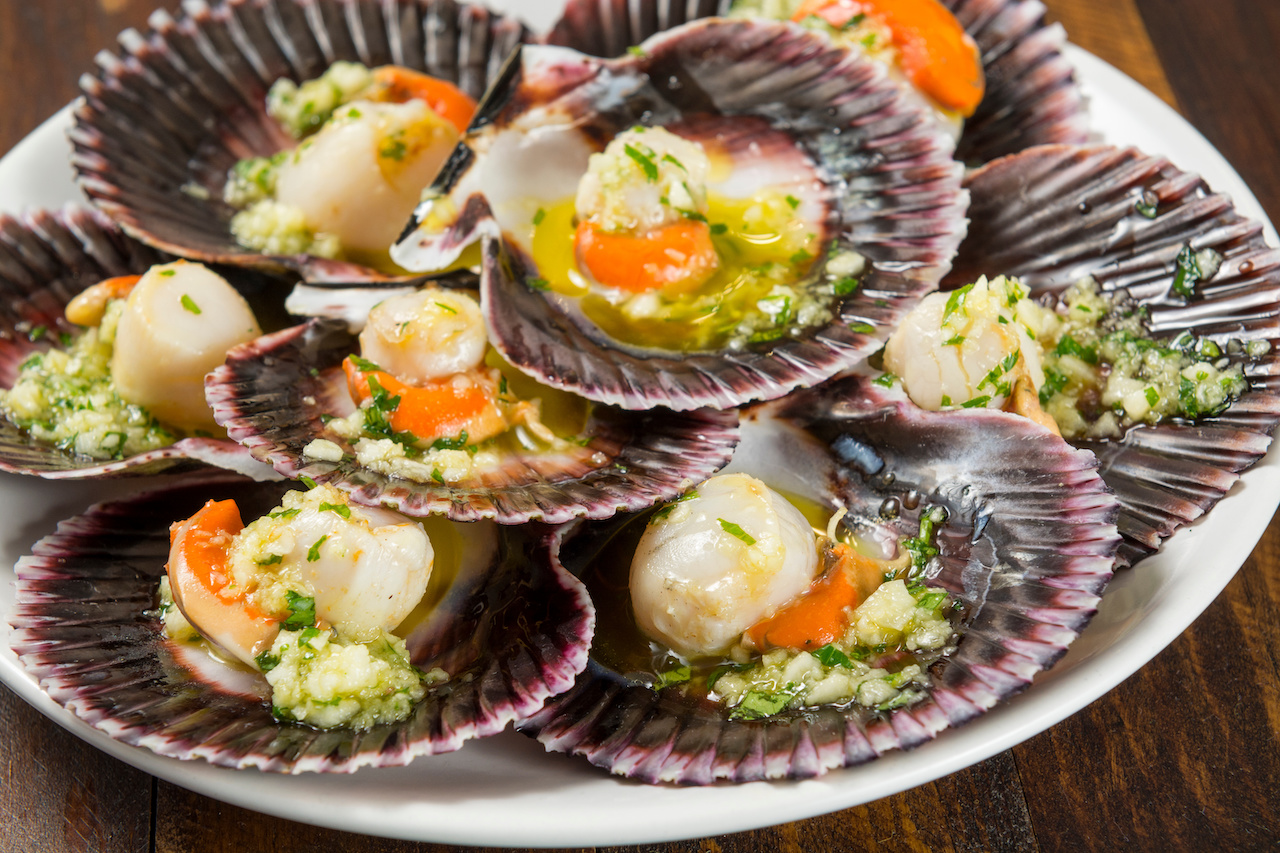
Literature and Poetry:
The Camino de Santiago has been a recurring theme in literature and poetry. The pilgrimage has been chronicled in accounts, travelogues, and personal narratives by pilgrims throughout history. Notable literary works include the Codex Calixtinus, a medieval manuscript that documents the pilgrimage, and "The Pilgrimage" by Paulo Coelho, a modern-day account of a pilgrimage to Santiago de Compostela.

"The Pilgrimage" is a novel written by Brazilian author Paulo Coelho. Published in 1987, it is a semi-autobiographical account of Coelho's own spiritual journey along the Way of St. James, the same pilgrimage route discussed earlier. Here is a brief overview of "The Pilgrimage":
The story follows the protagonist, Paulo, who embarks on a journey to find his personal legend, a term used in Coelho's works to represent one's true purpose or destiny. Paulo sets out on the Camino de Santiago, the pilgrimage route to Santiago de Compostela, in search of spiritual enlightenment and self-discovery.
Throughout his journey, Paulo encounters various trials, both external and internal, that test his determination and faith. He encounters mystical experiences, meets a variety of characters, and delves into spiritual teachings and practices. Guided by a spiritual mentor named Petrus, Paulo learns important lessons about overcoming fear, embracing the present moment, and trusting in the journey of life.
"The Pilgrimage" delves into themes of self-discovery, spirituality, and the pursuit of one's dreams. Coelho weaves together elements of adventure, mysticism, and philosophy to create a narrative that explores the transformative power of pilgrimage and the significance of inner growth.
The novel's introspective nature and poetic storytelling reflect Coelho's writing style, known for its philosophical insights and inspirational messages. "The Pilgrimage" serves as a precursor to Coelho's most famous work, "The Alchemist," which further explores similar themes of personal fulfillment and the pursuit of one's dreams.
Overall, "The Pilgrimage" is a captivating and thought-provoking novel that invites readers to reflect on their own spiritual journey and quest for meaning. It offers a glimpse into the transformative power of pilgrimage and the potential for self-discovery along the path of personal growth and enlightenment.
Music and Performing Arts:
The pilgrimage has influenced musical compositions, traditional songs, and performances. The Codex Calixtinus contains musical pieces for liturgical use along the Camino. Traditional Galician music, including bagpipe (gaita) music, often features pilgrimage-related themes. In addition, theatrical performances, dance, and storytelling have incorporated the pilgrimage as a cultural motif.
Festivals and Celebrations:
The pilgrimage has given rise to festivals and celebrations that showcase local culture and traditions. The Feast of St. James (Santiago Apóstol) on July 25th, which marks the saint's martyrdom, is celebrated with processions, religious ceremonies, and cultural events. These festivities bring together locals and pilgrims, creating a sense of community and reinforcing cultural identity.
Cultural Exchange:
The pilgrimage has facilitated cultural exchange and interaction between pilgrims from different countries and backgrounds. As pilgrims journey along the Camino, they share stories, customs, and experiences, creating a unique cultural exchange that contributes to a broader understanding and appreciation of different cultures and perspectives.
The cultural and artistic impact of the pilgrimage extends beyond Santiago de Compostela itself. It has influenced regional traditions, folklore, and artistic expressions in Galicia and has left an indelible mark on the cultural heritage of the communities along the Camino de Santiago.
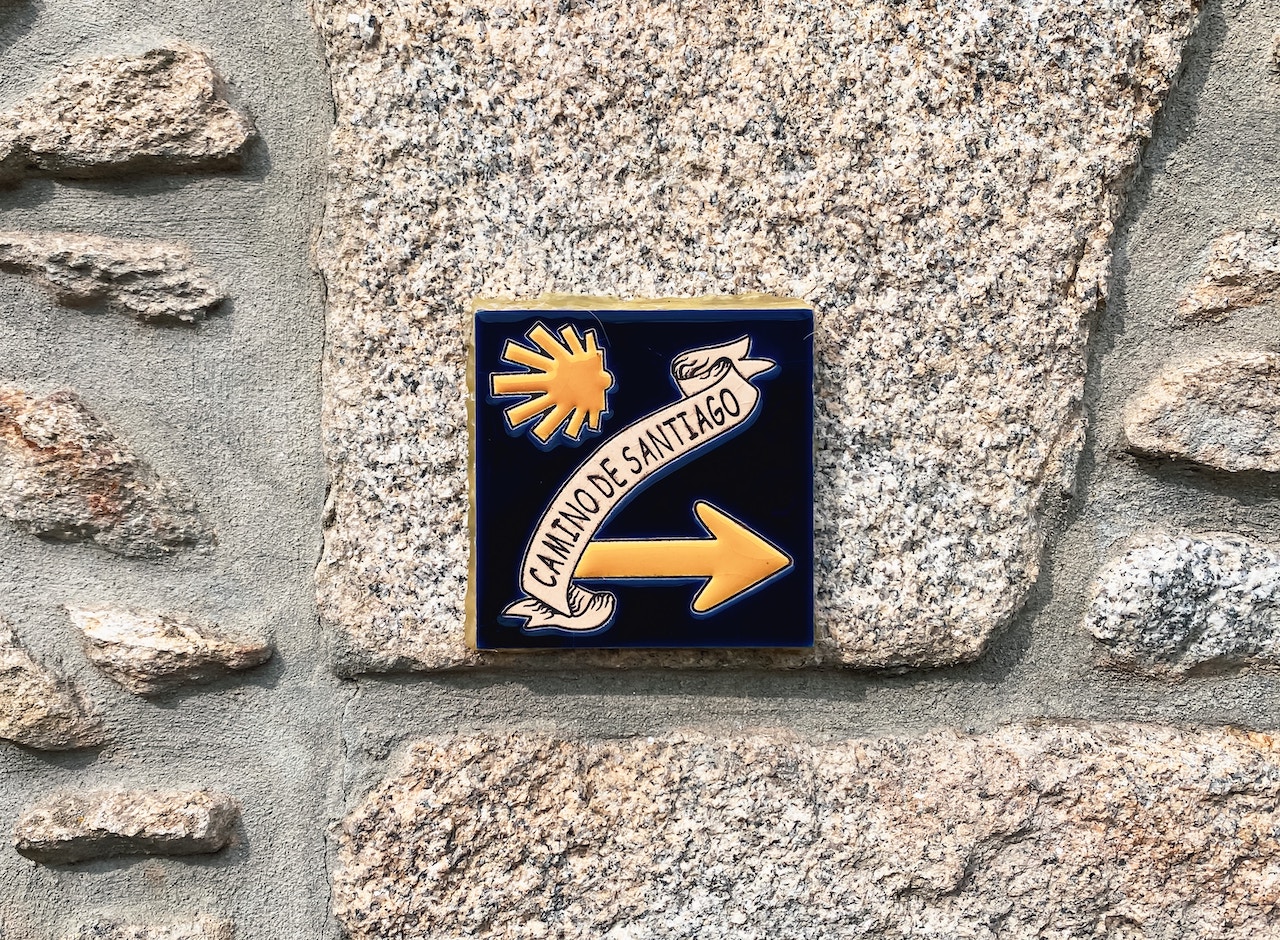
As our journey along the Way of St. James comes to an end, we are left with a profound sense of awe and inspiration. This pilgrimage, steeped in centuries of history, has woven together the threads of spirituality, culture, and adventure into a tapestry of unforgettable experiences. Through the footsteps of countless pilgrims, we have discovered the transformative power of the Camino de Santiago. The path has led us through picturesque landscapes, quaint villages, and majestic cities, offering glimpses of the past and opportunities for self-reflection.
Santiago de Compostela, with its resplendent cathedral and vibrant energy, stands as the ultimate reward for the weary pilgrim. Here, stories merge, and hearts find solace as pilgrims from all corners of the globe gather to celebrate their journey's end. Yet, the Way of St. James is not merely a physical trail; it is a path that transcends boundaries, beliefs, and backgrounds. It unites people from diverse cultures and inspires profound moments of introspection and connection.

In this pilgrimage, we have witnessed the harmonious blend of tradition and modernity, where ancient rituals coexist with bustling tourism. It is a testament to the enduring allure of the Camino de Santiago, which continues to captivate the hearts of pilgrims and adventurers alike.
As we conclude our exploration, we carry with us the memories of breathtaking landscapes, shared meals, heartfelt conversations, and the unbreakable bond forged along the Way. The Way of St. James is a pilgrimage that goes far beyond the physical act of walking; it is a journey that nourishes the soul and leaves an indelible mark on our lives. So, whether you embark on this pilgrimage for religious devotion, personal growth, or a desire for adventure, the Way of St. James awaits, ready to unfold its secrets, touch your spirit, and transform your perspective.
In the end, the Camino de Santiago is not just a destination; it is an invitation to embark on a pilgrimage of self-discovery, community, and profound beauty. So, lace up your boots, pick up your pilgrim's passport, and embark on this extraordinary journey that has captivated the hearts of countless pilgrims for centuries. The Way of St. James awaits, ready to reveal its wonders and change your life forever.
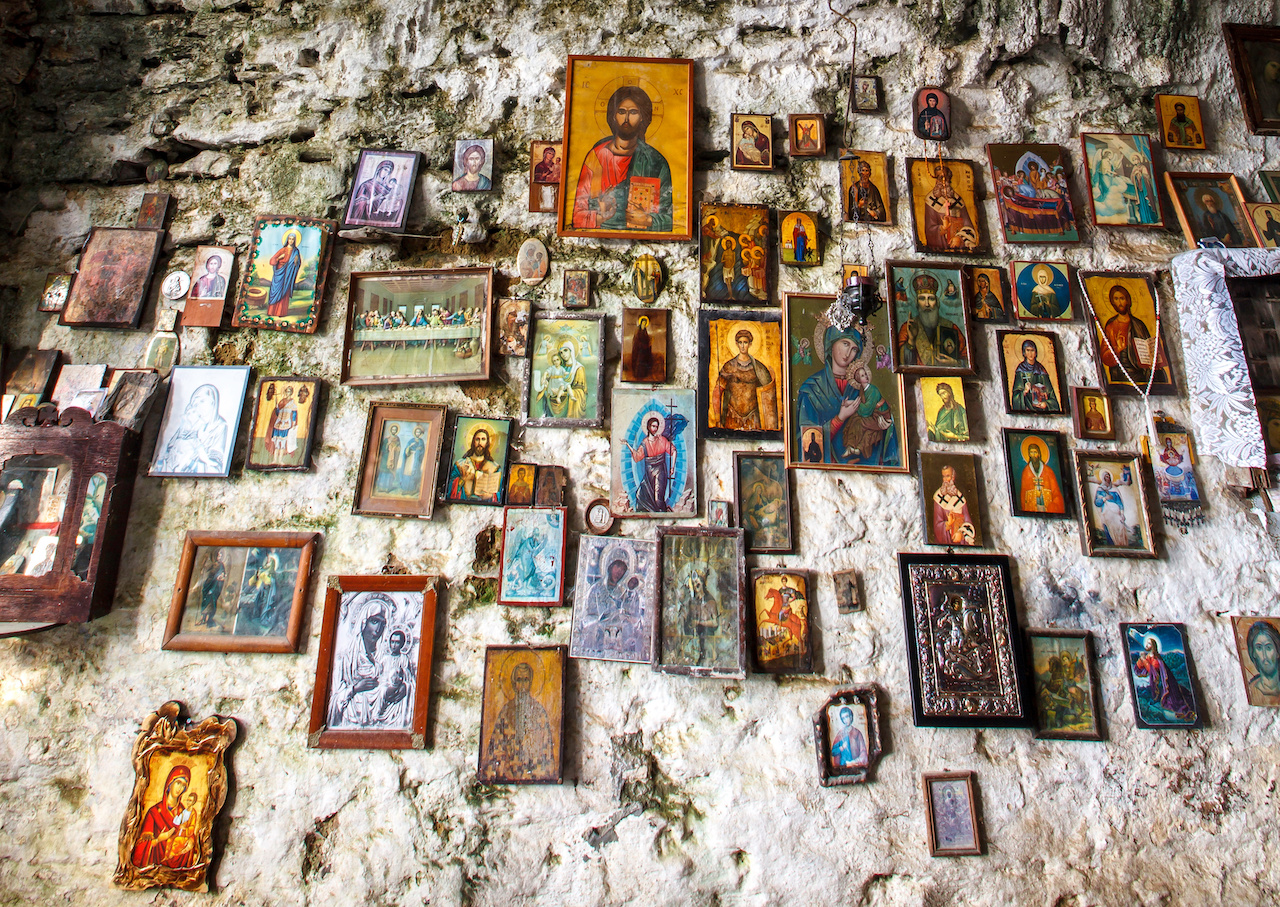
Read our previous article A private tour of the Burmese Mystery - unveiling the Golden Land! (part II)
Read our next article Top shore-excursions in the busiest cruise ports of Europe in summer 2023 - ROTTERDAM, THE NETHERLANDS










